Assessing Communication Skills and Styles
VerifiedAdded on 2020/05/16
|24
|5058
|53
AI Summary
This assignment delves into the assessment of various communication skills and styles. It presents diagnostic tools to evaluate a student's willingness to listen, tolerance for disagreement, tendency towards compulsive talking (using the Talkaholic Scale), and self-perceived nonverbal immediacy. The provided resources aim to help students understand their strengths and weaknesses in different aspects of communication.
Contribute Materials
Your contribution can guide someone’s learning journey. Share your
documents today.
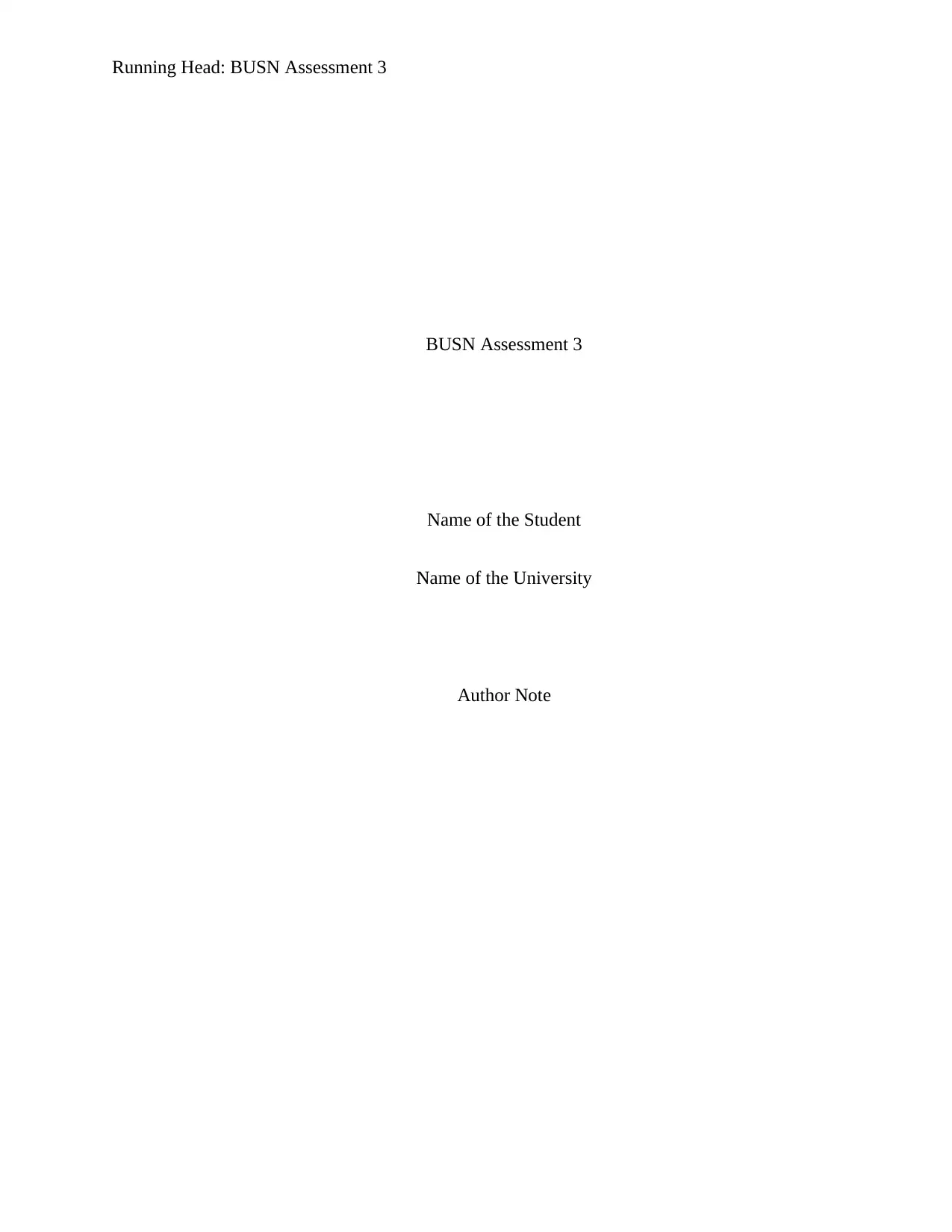
Running Head: BUSN Assessment 3
BUSN Assessment 3
Name of the Student
Name of the University
Author Note
BUSN Assessment 3
Name of the Student
Name of the University
Author Note
Secure Best Marks with AI Grader
Need help grading? Try our AI Grader for instant feedback on your assignments.

1BUSN ASSESSMENT 3
Table of Contents
Introduction..........................................................................................................................2
Diagnosis and reflection......................................................................................................2
Literature review..................................................................................................................7
Action plan.........................................................................................................................12
Conclusion.........................................................................................................................15
References..........................................................................................................................16
Appendix............................................................................................................................19
Table of Contents
Introduction..........................................................................................................................2
Diagnosis and reflection......................................................................................................2
Literature review..................................................................................................................7
Action plan.........................................................................................................................12
Conclusion.........................................................................................................................15
References..........................................................................................................................16
Appendix............................................................................................................................19
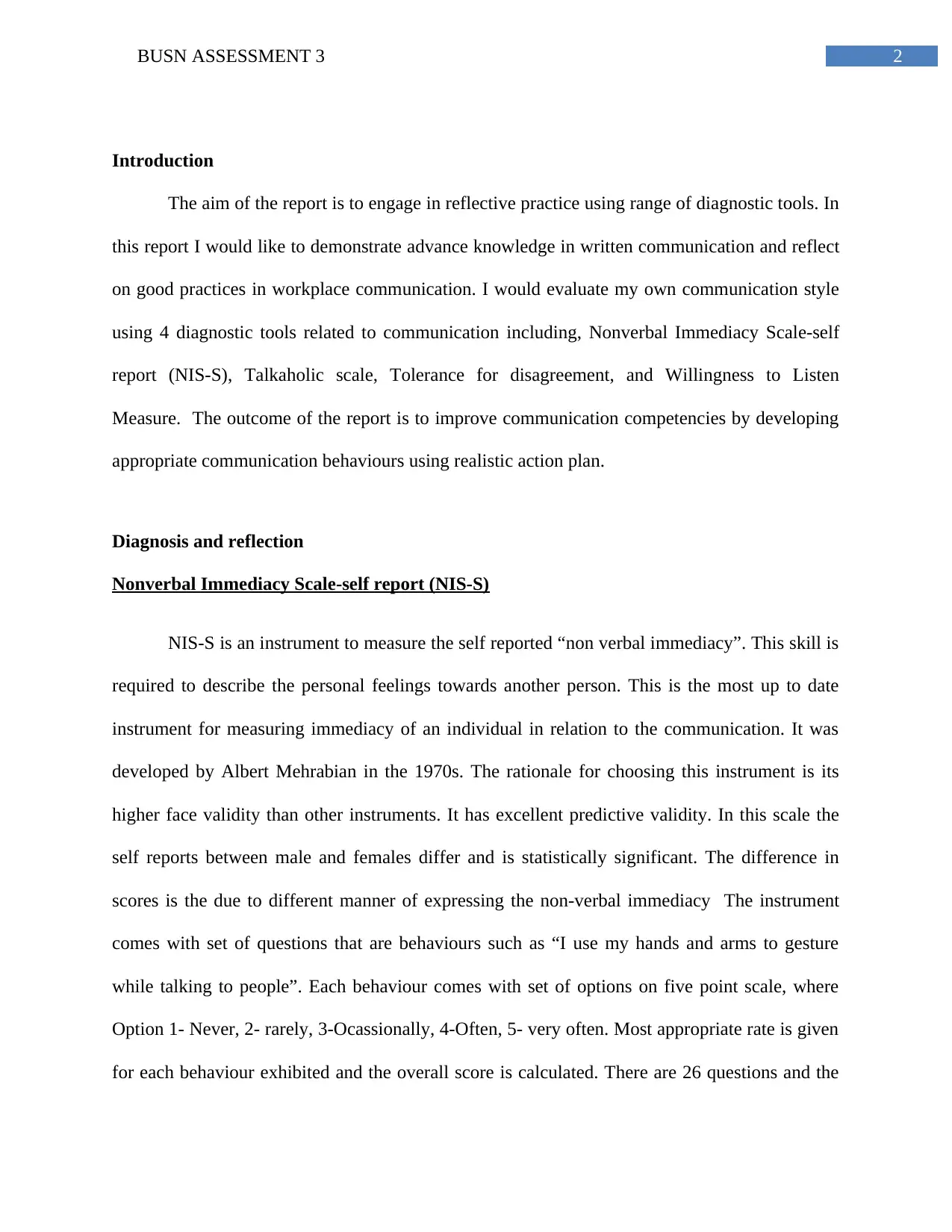
2BUSN ASSESSMENT 3
Introduction
The aim of the report is to engage in reflective practice using range of diagnostic tools. In
this report I would like to demonstrate advance knowledge in written communication and reflect
on good practices in workplace communication. I would evaluate my own communication style
using 4 diagnostic tools related to communication including, Nonverbal Immediacy Scale-self
report (NIS-S), Talkaholic scale, Tolerance for disagreement, and Willingness to Listen
Measure. The outcome of the report is to improve communication competencies by developing
appropriate communication behaviours using realistic action plan.
Diagnosis and reflection
Nonverbal Immediacy Scale-self report (NIS-S)
NIS-S is an instrument to measure the self reported “non verbal immediacy”. This skill is
required to describe the personal feelings towards another person. This is the most up to date
instrument for measuring immediacy of an individual in relation to the communication. It was
developed by Albert Mehrabian in the 1970s. The rationale for choosing this instrument is its
higher face validity than other instruments. It has excellent predictive validity. In this scale the
self reports between male and females differ and is statistically significant. The difference in
scores is the due to different manner of expressing the non-verbal immediacy The instrument
comes with set of questions that are behaviours such as “I use my hands and arms to gesture
while talking to people”. Each behaviour comes with set of options on five point scale, where
Option 1- Never, 2- rarely, 3-Ocassionally, 4-Often, 5- very often. Most appropriate rate is given
for each behaviour exhibited and the overall score is calculated. There are 26 questions and the
Introduction
The aim of the report is to engage in reflective practice using range of diagnostic tools. In
this report I would like to demonstrate advance knowledge in written communication and reflect
on good practices in workplace communication. I would evaluate my own communication style
using 4 diagnostic tools related to communication including, Nonverbal Immediacy Scale-self
report (NIS-S), Talkaholic scale, Tolerance for disagreement, and Willingness to Listen
Measure. The outcome of the report is to improve communication competencies by developing
appropriate communication behaviours using realistic action plan.
Diagnosis and reflection
Nonverbal Immediacy Scale-self report (NIS-S)
NIS-S is an instrument to measure the self reported “non verbal immediacy”. This skill is
required to describe the personal feelings towards another person. This is the most up to date
instrument for measuring immediacy of an individual in relation to the communication. It was
developed by Albert Mehrabian in the 1970s. The rationale for choosing this instrument is its
higher face validity than other instruments. It has excellent predictive validity. In this scale the
self reports between male and females differ and is statistically significant. The difference in
scores is the due to different manner of expressing the non-verbal immediacy The instrument
comes with set of questions that are behaviours such as “I use my hands and arms to gesture
while talking to people”. Each behaviour comes with set of options on five point scale, where
Option 1- Never, 2- rarely, 3-Ocassionally, 4-Often, 5- very often. Most appropriate rate is given
for each behaviour exhibited and the overall score is calculated. There are 26 questions and the
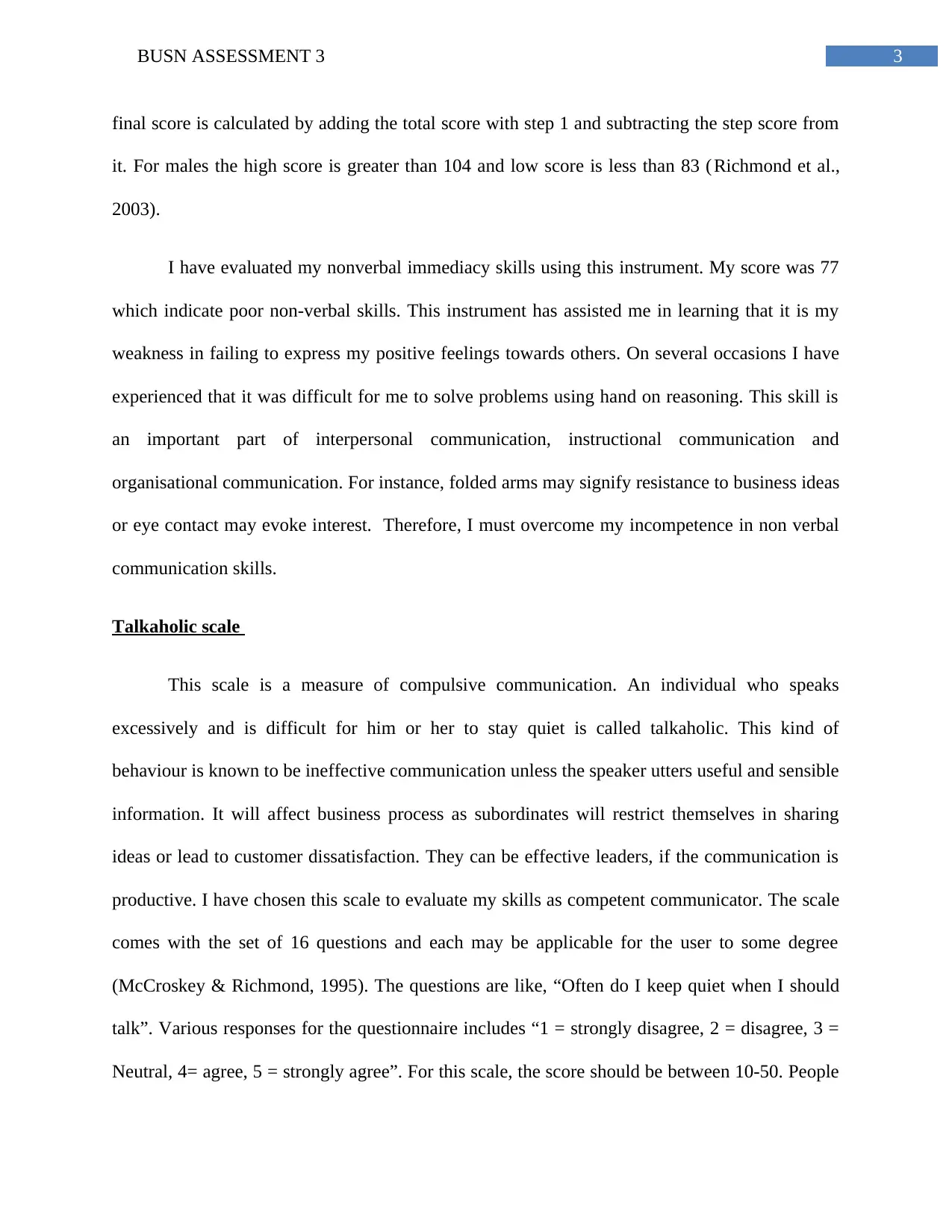
3BUSN ASSESSMENT 3
final score is calculated by adding the total score with step 1 and subtracting the step score from
it. For males the high score is greater than 104 and low score is less than 83 ( Richmond et al.,
2003).
I have evaluated my nonverbal immediacy skills using this instrument. My score was 77
which indicate poor non-verbal skills. This instrument has assisted me in learning that it is my
weakness in failing to express my positive feelings towards others. On several occasions I have
experienced that it was difficult for me to solve problems using hand on reasoning. This skill is
an important part of interpersonal communication, instructional communication and
organisational communication. For instance, folded arms may signify resistance to business ideas
or eye contact may evoke interest. Therefore, I must overcome my incompetence in non verbal
communication skills.
Talkaholic scale
This scale is a measure of compulsive communication. An individual who speaks
excessively and is difficult for him or her to stay quiet is called talkaholic. This kind of
behaviour is known to be ineffective communication unless the speaker utters useful and sensible
information. It will affect business process as subordinates will restrict themselves in sharing
ideas or lead to customer dissatisfaction. They can be effective leaders, if the communication is
productive. I have chosen this scale to evaluate my skills as competent communicator. The scale
comes with the set of 16 questions and each may be applicable for the user to some degree
(McCroskey & Richmond, 1995). The questions are like, “Often do I keep quiet when I should
talk”. Various responses for the questionnaire includes “1 = strongly disagree, 2 = disagree, 3 =
Neutral, 4= agree, 5 = strongly agree”. For this scale, the score should be between 10-50. People
final score is calculated by adding the total score with step 1 and subtracting the step score from
it. For males the high score is greater than 104 and low score is less than 83 ( Richmond et al.,
2003).
I have evaluated my nonverbal immediacy skills using this instrument. My score was 77
which indicate poor non-verbal skills. This instrument has assisted me in learning that it is my
weakness in failing to express my positive feelings towards others. On several occasions I have
experienced that it was difficult for me to solve problems using hand on reasoning. This skill is
an important part of interpersonal communication, instructional communication and
organisational communication. For instance, folded arms may signify resistance to business ideas
or eye contact may evoke interest. Therefore, I must overcome my incompetence in non verbal
communication skills.
Talkaholic scale
This scale is a measure of compulsive communication. An individual who speaks
excessively and is difficult for him or her to stay quiet is called talkaholic. This kind of
behaviour is known to be ineffective communication unless the speaker utters useful and sensible
information. It will affect business process as subordinates will restrict themselves in sharing
ideas or lead to customer dissatisfaction. They can be effective leaders, if the communication is
productive. I have chosen this scale to evaluate my skills as competent communicator. The scale
comes with the set of 16 questions and each may be applicable for the user to some degree
(McCroskey & Richmond, 1995). The questions are like, “Often do I keep quiet when I should
talk”. Various responses for the questionnaire includes “1 = strongly disagree, 2 = disagree, 3 =
Neutral, 4= agree, 5 = strongly agree”. For this scale, the score should be between 10-50. People
Secure Best Marks with AI Grader
Need help grading? Try our AI Grader for instant feedback on your assignments.

4BUSN ASSESSMENT 3
scoring between 30-39 are referred as borderline talkholics. Individuals falling in this range can
control talking for most of the time. However, they may fail to be quiet even it is advantageous
for them. Those scoring above 40 are talkaholics. Such people are dominating and fail to
accomplish corporate dealings. This instrument is reliable with strong face validity (McCroskey
& Richmond, 1993).
I have evaluated myself using this scale and the score is 28. It means I am not
compulsive communicator. This score indicates that I do not have the tendency to over
communicate in a consistent manner. It may be regarded that I am competent in communication
and may be inhibited by others. It can be related to my experience where I found a conflicting
situation arising among my high school friends. I was quiet as my involvement would have only
exaggerated others irritation.
Tolerance for disagreement
This instrument is used to measure the ability of an individual to communicate with
others despite high chances of disagreement. It is the skill where an individual engages with
other having different perspective and opinion. Such people support other’s rights to express
their ideas and positively support the debate and prevent traumatic ordeal. It will have positive
impact on the employee satisfaction. It will lead to stronger relationship with clients. Having this
skill is essential for people in managerial position to express ideas and mange the seniors
responses towards organisational change. The instrument comes with set of 15 questions that
describe the individual’s feelings and orientations. It involves items like, “Disagreements are
generally helpful”. The reaction to the each item is rated as per five pint Likert scale. “1 =
strongly disagree, 2 = disagree, 3 = Undecided, 4= agree, 5 = strongly agree”. As score above 46
scoring between 30-39 are referred as borderline talkholics. Individuals falling in this range can
control talking for most of the time. However, they may fail to be quiet even it is advantageous
for them. Those scoring above 40 are talkaholics. Such people are dominating and fail to
accomplish corporate dealings. This instrument is reliable with strong face validity (McCroskey
& Richmond, 1993).
I have evaluated myself using this scale and the score is 28. It means I am not
compulsive communicator. This score indicates that I do not have the tendency to over
communicate in a consistent manner. It may be regarded that I am competent in communication
and may be inhibited by others. It can be related to my experience where I found a conflicting
situation arising among my high school friends. I was quiet as my involvement would have only
exaggerated others irritation.
Tolerance for disagreement
This instrument is used to measure the ability of an individual to communicate with
others despite high chances of disagreement. It is the skill where an individual engages with
other having different perspective and opinion. Such people support other’s rights to express
their ideas and positively support the debate and prevent traumatic ordeal. It will have positive
impact on the employee satisfaction. It will lead to stronger relationship with clients. Having this
skill is essential for people in managerial position to express ideas and mange the seniors
responses towards organisational change. The instrument comes with set of 15 questions that
describe the individual’s feelings and orientations. It involves items like, “Disagreements are
generally helpful”. The reaction to the each item is rated as per five pint Likert scale. “1 =
strongly disagree, 2 = disagree, 3 = Undecided, 4= agree, 5 = strongly agree”. As score above 46
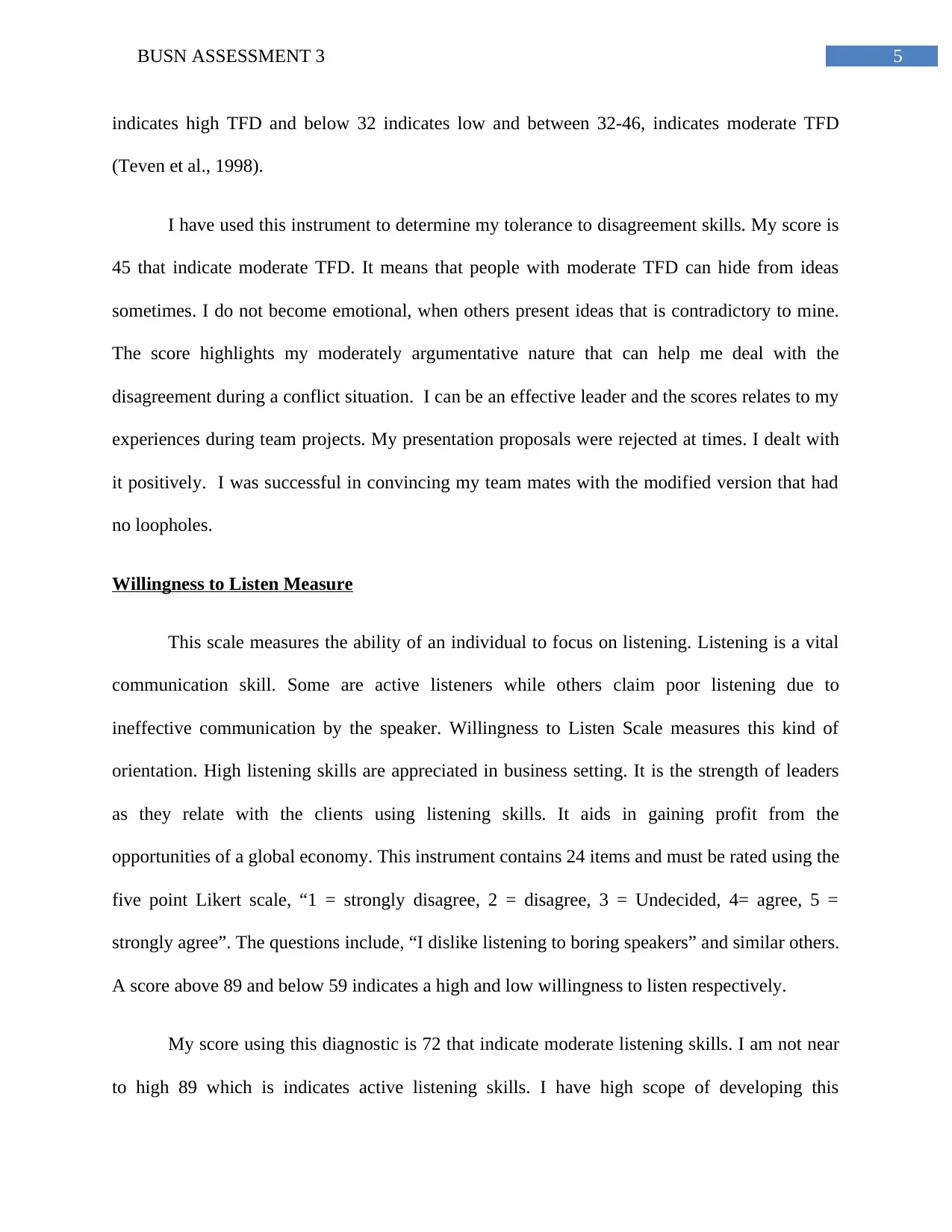
5BUSN ASSESSMENT 3
indicates high TFD and below 32 indicates low and between 32-46, indicates moderate TFD
(Teven et al., 1998).
I have used this instrument to determine my tolerance to disagreement skills. My score is
45 that indicate moderate TFD. It means that people with moderate TFD can hide from ideas
sometimes. I do not become emotional, when others present ideas that is contradictory to mine.
The score highlights my moderately argumentative nature that can help me deal with the
disagreement during a conflict situation. I can be an effective leader and the scores relates to my
experiences during team projects. My presentation proposals were rejected at times. I dealt with
it positively. I was successful in convincing my team mates with the modified version that had
no loopholes.
Willingness to Listen Measure
This scale measures the ability of an individual to focus on listening. Listening is a vital
communication skill. Some are active listeners while others claim poor listening due to
ineffective communication by the speaker. Willingness to Listen Scale measures this kind of
orientation. High listening skills are appreciated in business setting. It is the strength of leaders
as they relate with the clients using listening skills. It aids in gaining profit from the
opportunities of a global economy. This instrument contains 24 items and must be rated using the
five point Likert scale, “1 = strongly disagree, 2 = disagree, 3 = Undecided, 4= agree, 5 =
strongly agree”. The questions include, “I dislike listening to boring speakers” and similar others.
A score above 89 and below 59 indicates a high and low willingness to listen respectively.
My score using this diagnostic is 72 that indicate moderate listening skills. I am not near
to high 89 which is indicates active listening skills. I have high scope of developing this
indicates high TFD and below 32 indicates low and between 32-46, indicates moderate TFD
(Teven et al., 1998).
I have used this instrument to determine my tolerance to disagreement skills. My score is
45 that indicate moderate TFD. It means that people with moderate TFD can hide from ideas
sometimes. I do not become emotional, when others present ideas that is contradictory to mine.
The score highlights my moderately argumentative nature that can help me deal with the
disagreement during a conflict situation. I can be an effective leader and the scores relates to my
experiences during team projects. My presentation proposals were rejected at times. I dealt with
it positively. I was successful in convincing my team mates with the modified version that had
no loopholes.
Willingness to Listen Measure
This scale measures the ability of an individual to focus on listening. Listening is a vital
communication skill. Some are active listeners while others claim poor listening due to
ineffective communication by the speaker. Willingness to Listen Scale measures this kind of
orientation. High listening skills are appreciated in business setting. It is the strength of leaders
as they relate with the clients using listening skills. It aids in gaining profit from the
opportunities of a global economy. This instrument contains 24 items and must be rated using the
five point Likert scale, “1 = strongly disagree, 2 = disagree, 3 = Undecided, 4= agree, 5 =
strongly agree”. The questions include, “I dislike listening to boring speakers” and similar others.
A score above 89 and below 59 indicates a high and low willingness to listen respectively.
My score using this diagnostic is 72 that indicate moderate listening skills. I am not near
to high 89 which is indicates active listening skills. I have high scope of developing this
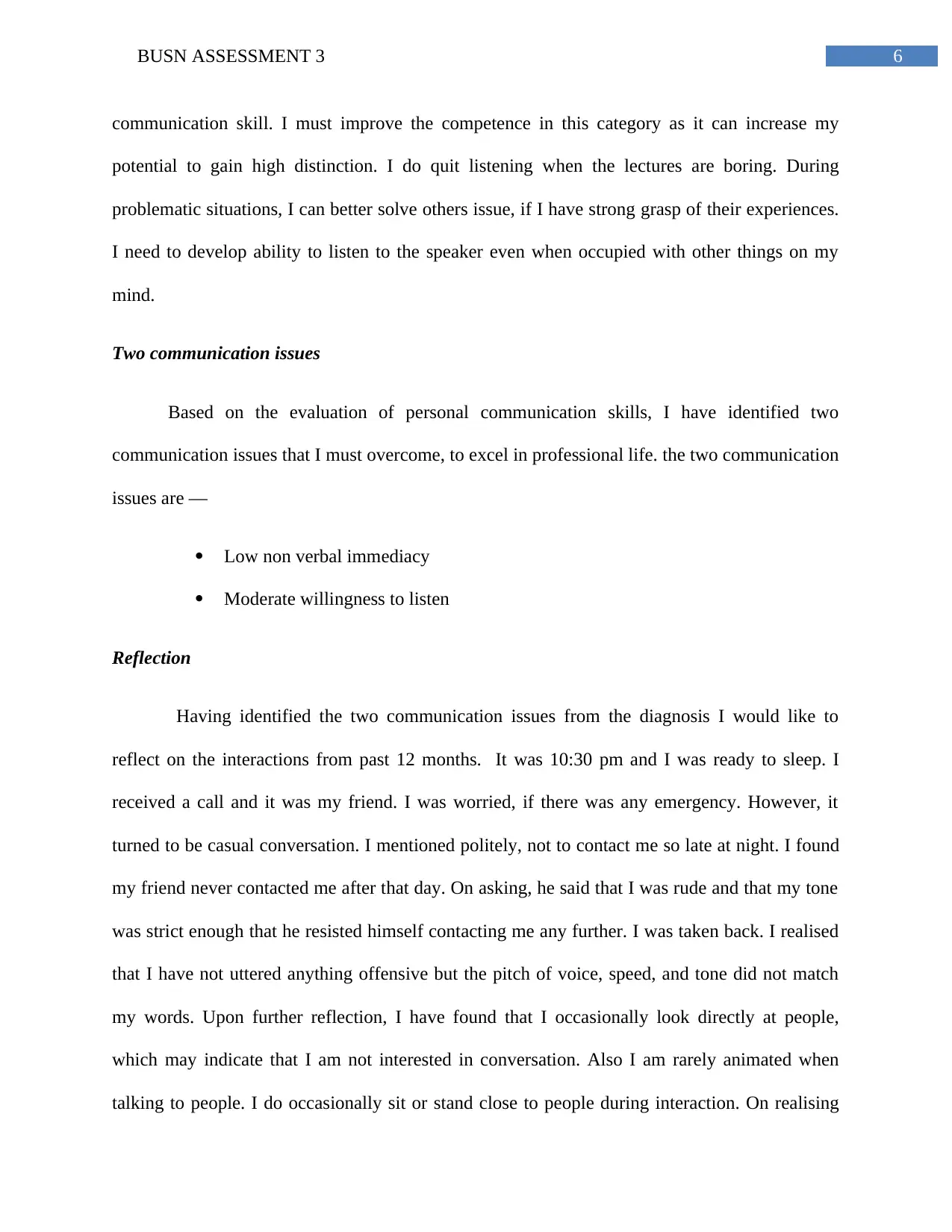
6BUSN ASSESSMENT 3
communication skill. I must improve the competence in this category as it can increase my
potential to gain high distinction. I do quit listening when the lectures are boring. During
problematic situations, I can better solve others issue, if I have strong grasp of their experiences.
I need to develop ability to listen to the speaker even when occupied with other things on my
mind.
Two communication issues
Based on the evaluation of personal communication skills, I have identified two
communication issues that I must overcome, to excel in professional life. the two communication
issues are —
Low non verbal immediacy
Moderate willingness to listen
Reflection
Having identified the two communication issues from the diagnosis I would like to
reflect on the interactions from past 12 months. It was 10:30 pm and I was ready to sleep. I
received a call and it was my friend. I was worried, if there was any emergency. However, it
turned to be casual conversation. I mentioned politely, not to contact me so late at night. I found
my friend never contacted me after that day. On asking, he said that I was rude and that my tone
was strict enough that he resisted himself contacting me any further. I was taken back. I realised
that I have not uttered anything offensive but the pitch of voice, speed, and tone did not match
my words. Upon further reflection, I have found that I occasionally look directly at people,
which may indicate that I am not interested in conversation. Also I am rarely animated when
talking to people. I do occasionally sit or stand close to people during interaction. On realising
communication skill. I must improve the competence in this category as it can increase my
potential to gain high distinction. I do quit listening when the lectures are boring. During
problematic situations, I can better solve others issue, if I have strong grasp of their experiences.
I need to develop ability to listen to the speaker even when occupied with other things on my
mind.
Two communication issues
Based on the evaluation of personal communication skills, I have identified two
communication issues that I must overcome, to excel in professional life. the two communication
issues are —
Low non verbal immediacy
Moderate willingness to listen
Reflection
Having identified the two communication issues from the diagnosis I would like to
reflect on the interactions from past 12 months. It was 10:30 pm and I was ready to sleep. I
received a call and it was my friend. I was worried, if there was any emergency. However, it
turned to be casual conversation. I mentioned politely, not to contact me so late at night. I found
my friend never contacted me after that day. On asking, he said that I was rude and that my tone
was strict enough that he resisted himself contacting me any further. I was taken back. I realised
that I have not uttered anything offensive but the pitch of voice, speed, and tone did not match
my words. Upon further reflection, I have found that I occasionally look directly at people,
which may indicate that I am not interested in conversation. Also I am rarely animated when
talking to people. I do occasionally sit or stand close to people during interaction. On realising
Paraphrase This Document
Need a fresh take? Get an instant paraphrase of this document with our AI Paraphraser
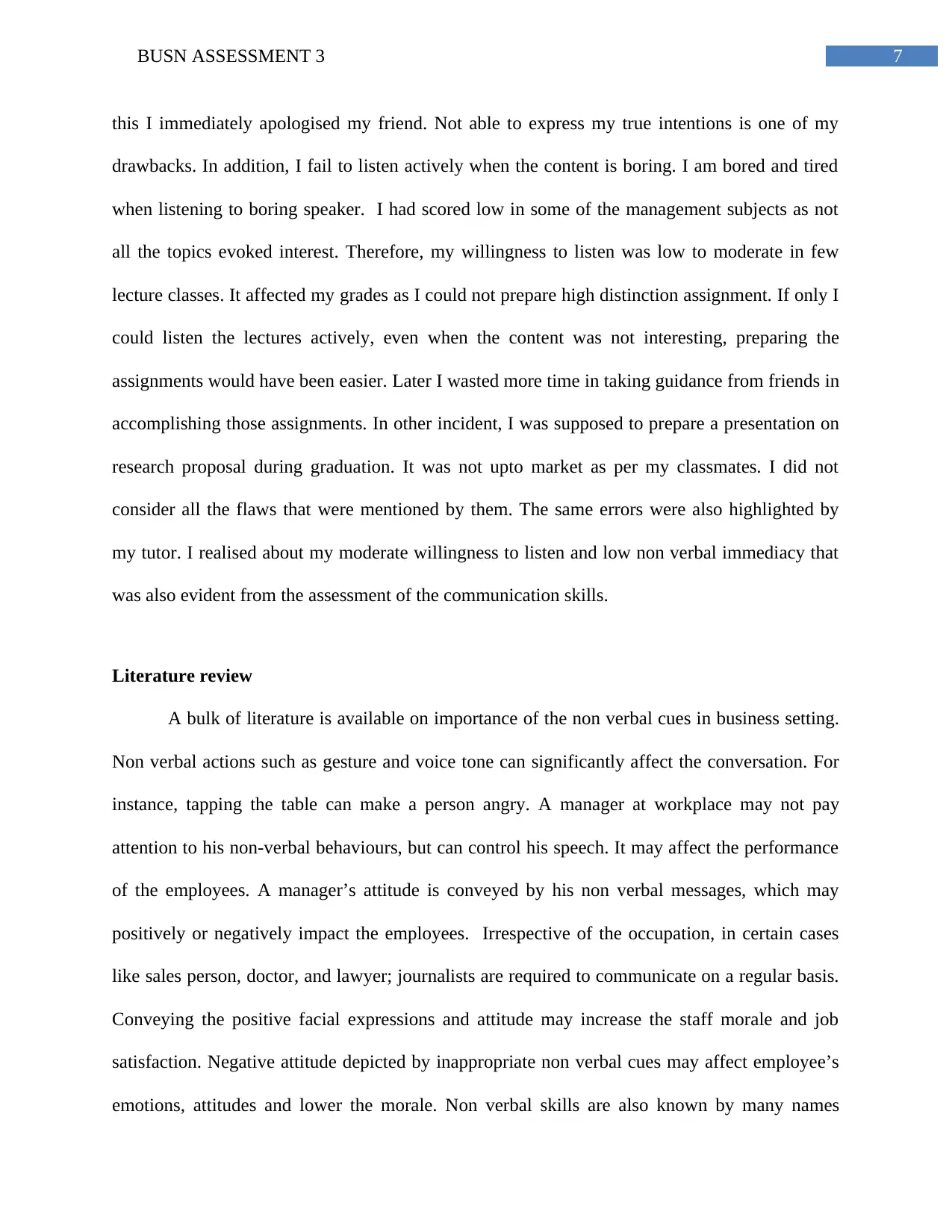
7BUSN ASSESSMENT 3
this I immediately apologised my friend. Not able to express my true intentions is one of my
drawbacks. In addition, I fail to listen actively when the content is boring. I am bored and tired
when listening to boring speaker. I had scored low in some of the management subjects as not
all the topics evoked interest. Therefore, my willingness to listen was low to moderate in few
lecture classes. It affected my grades as I could not prepare high distinction assignment. If only I
could listen the lectures actively, even when the content was not interesting, preparing the
assignments would have been easier. Later I wasted more time in taking guidance from friends in
accomplishing those assignments. In other incident, I was supposed to prepare a presentation on
research proposal during graduation. It was not upto market as per my classmates. I did not
consider all the flaws that were mentioned by them. The same errors were also highlighted by
my tutor. I realised about my moderate willingness to listen and low non verbal immediacy that
was also evident from the assessment of the communication skills.
Literature review
A bulk of literature is available on importance of the non verbal cues in business setting.
Non verbal actions such as gesture and voice tone can significantly affect the conversation. For
instance, tapping the table can make a person angry. A manager at workplace may not pay
attention to his non-verbal behaviours, but can control his speech. It may affect the performance
of the employees. A manager’s attitude is conveyed by his non verbal messages, which may
positively or negatively impact the employees. Irrespective of the occupation, in certain cases
like sales person, doctor, and lawyer; journalists are required to communicate on a regular basis.
Conveying the positive facial expressions and attitude may increase the staff morale and job
satisfaction. Negative attitude depicted by inappropriate non verbal cues may affect employee’s
emotions, attitudes and lower the morale. Non verbal skills are also known by many names
this I immediately apologised my friend. Not able to express my true intentions is one of my
drawbacks. In addition, I fail to listen actively when the content is boring. I am bored and tired
when listening to boring speaker. I had scored low in some of the management subjects as not
all the topics evoked interest. Therefore, my willingness to listen was low to moderate in few
lecture classes. It affected my grades as I could not prepare high distinction assignment. If only I
could listen the lectures actively, even when the content was not interesting, preparing the
assignments would have been easier. Later I wasted more time in taking guidance from friends in
accomplishing those assignments. In other incident, I was supposed to prepare a presentation on
research proposal during graduation. It was not upto market as per my classmates. I did not
consider all the flaws that were mentioned by them. The same errors were also highlighted by
my tutor. I realised about my moderate willingness to listen and low non verbal immediacy that
was also evident from the assessment of the communication skills.
Literature review
A bulk of literature is available on importance of the non verbal cues in business setting.
Non verbal actions such as gesture and voice tone can significantly affect the conversation. For
instance, tapping the table can make a person angry. A manager at workplace may not pay
attention to his non-verbal behaviours, but can control his speech. It may affect the performance
of the employees. A manager’s attitude is conveyed by his non verbal messages, which may
positively or negatively impact the employees. Irrespective of the occupation, in certain cases
like sales person, doctor, and lawyer; journalists are required to communicate on a regular basis.
Conveying the positive facial expressions and attitude may increase the staff morale and job
satisfaction. Negative attitude depicted by inappropriate non verbal cues may affect employee’s
emotions, attitudes and lower the morale. Non verbal skills are also known by many names
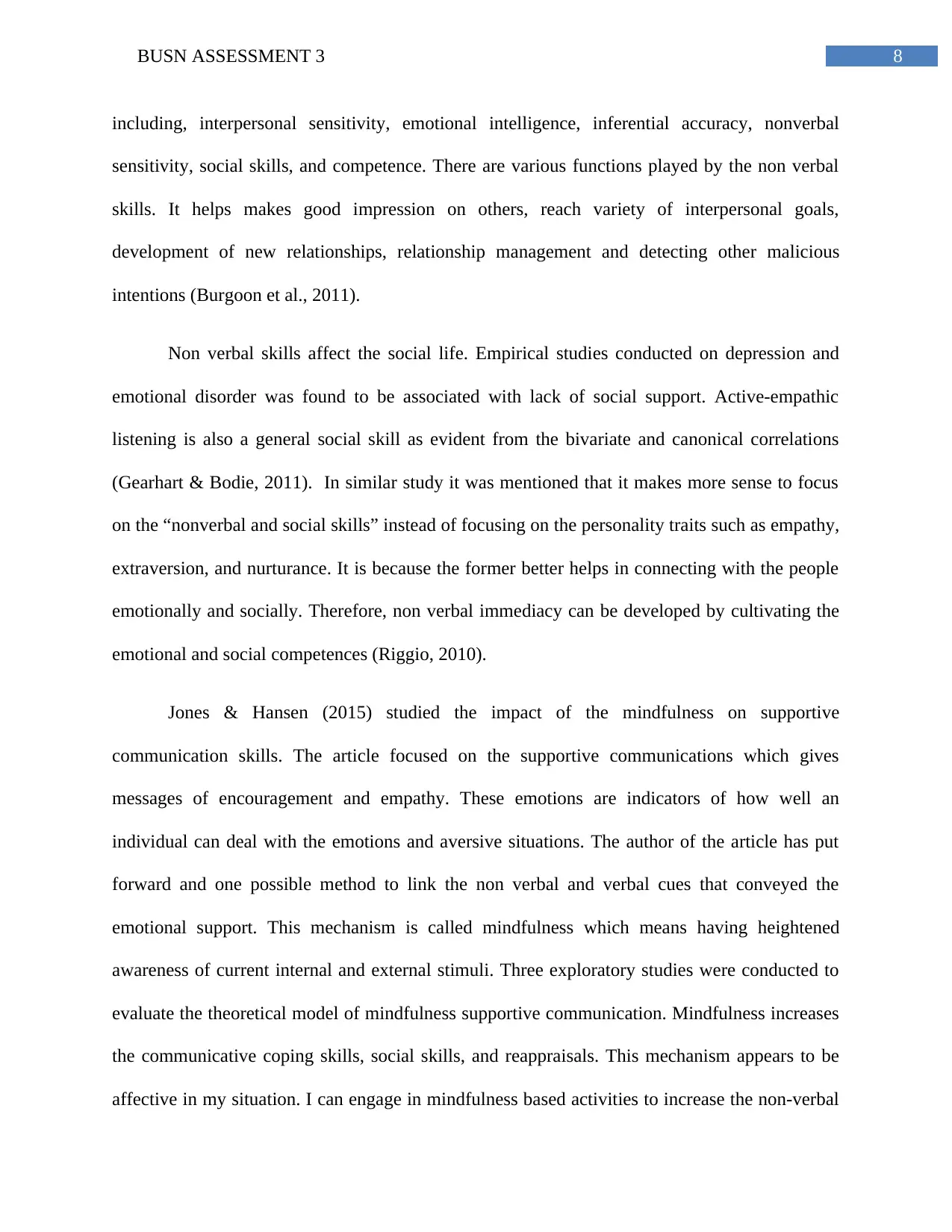
8BUSN ASSESSMENT 3
including, interpersonal sensitivity, emotional intelligence, inferential accuracy, nonverbal
sensitivity, social skills, and competence. There are various functions played by the non verbal
skills. It helps makes good impression on others, reach variety of interpersonal goals,
development of new relationships, relationship management and detecting other malicious
intentions (Burgoon et al., 2011).
Non verbal skills affect the social life. Empirical studies conducted on depression and
emotional disorder was found to be associated with lack of social support. Active-empathic
listening is also a general social skill as evident from the bivariate and canonical correlations
(Gearhart & Bodie, 2011). In similar study it was mentioned that it makes more sense to focus
on the “nonverbal and social skills” instead of focusing on the personality traits such as empathy,
extraversion, and nurturance. It is because the former better helps in connecting with the people
emotionally and socially. Therefore, non verbal immediacy can be developed by cultivating the
emotional and social competences (Riggio, 2010).
Jones & Hansen (2015) studied the impact of the mindfulness on supportive
communication skills. The article focused on the supportive communications which gives
messages of encouragement and empathy. These emotions are indicators of how well an
individual can deal with the emotions and aversive situations. The author of the article has put
forward and one possible method to link the non verbal and verbal cues that conveyed the
emotional support. This mechanism is called mindfulness which means having heightened
awareness of current internal and external stimuli. Three exploratory studies were conducted to
evaluate the theoretical model of mindfulness supportive communication. Mindfulness increases
the communicative coping skills, social skills, and reappraisals. This mechanism appears to be
affective in my situation. I can engage in mindfulness based activities to increase the non-verbal
including, interpersonal sensitivity, emotional intelligence, inferential accuracy, nonverbal
sensitivity, social skills, and competence. There are various functions played by the non verbal
skills. It helps makes good impression on others, reach variety of interpersonal goals,
development of new relationships, relationship management and detecting other malicious
intentions (Burgoon et al., 2011).
Non verbal skills affect the social life. Empirical studies conducted on depression and
emotional disorder was found to be associated with lack of social support. Active-empathic
listening is also a general social skill as evident from the bivariate and canonical correlations
(Gearhart & Bodie, 2011). In similar study it was mentioned that it makes more sense to focus
on the “nonverbal and social skills” instead of focusing on the personality traits such as empathy,
extraversion, and nurturance. It is because the former better helps in connecting with the people
emotionally and socially. Therefore, non verbal immediacy can be developed by cultivating the
emotional and social competences (Riggio, 2010).
Jones & Hansen (2015) studied the impact of the mindfulness on supportive
communication skills. The article focused on the supportive communications which gives
messages of encouragement and empathy. These emotions are indicators of how well an
individual can deal with the emotions and aversive situations. The author of the article has put
forward and one possible method to link the non verbal and verbal cues that conveyed the
emotional support. This mechanism is called mindfulness which means having heightened
awareness of current internal and external stimuli. Three exploratory studies were conducted to
evaluate the theoretical model of mindfulness supportive communication. Mindfulness increases
the communicative coping skills, social skills, and reappraisals. This mechanism appears to be
affective in my situation. I can engage in mindfulness based activities to increase the non-verbal
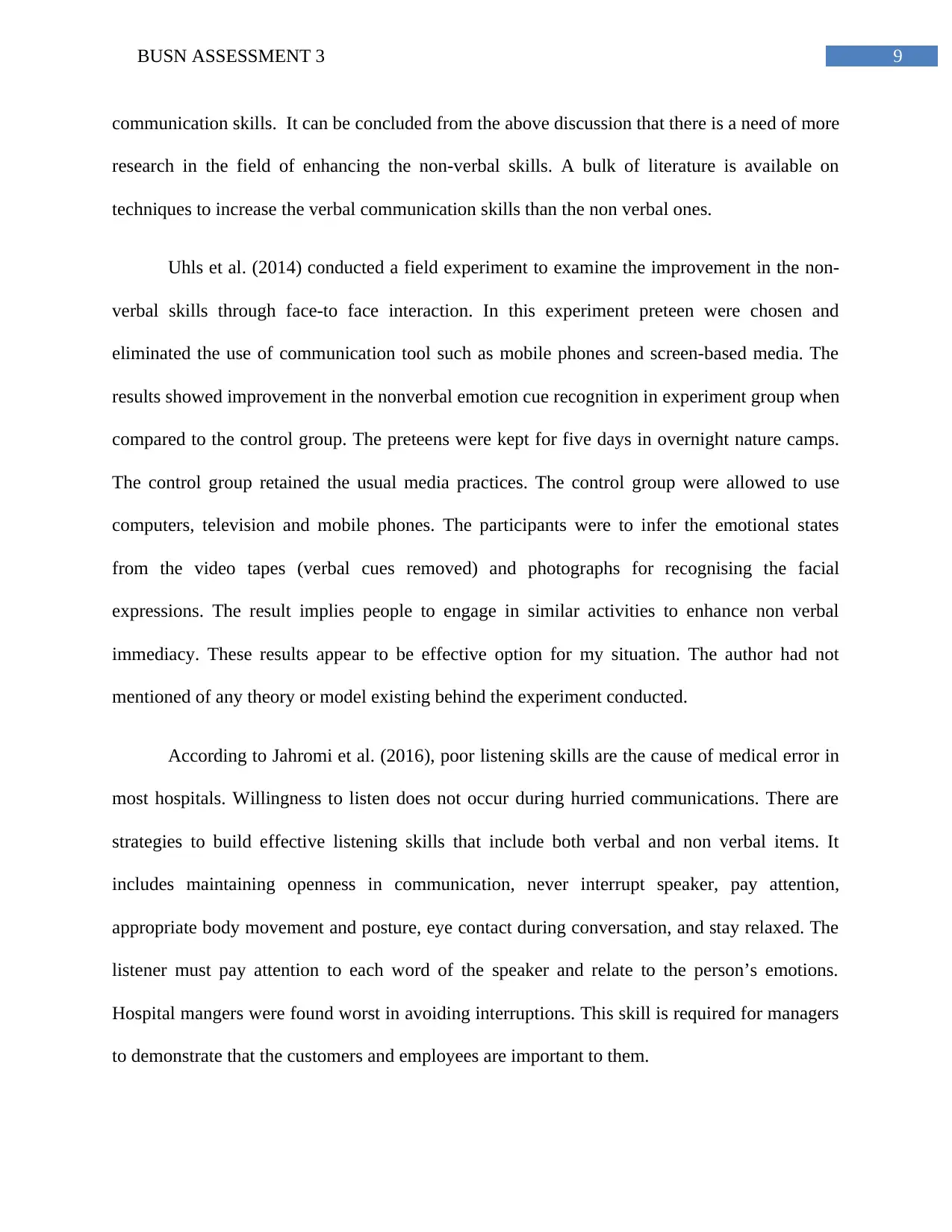
9BUSN ASSESSMENT 3
communication skills. It can be concluded from the above discussion that there is a need of more
research in the field of enhancing the non-verbal skills. A bulk of literature is available on
techniques to increase the verbal communication skills than the non verbal ones.
Uhls et al. (2014) conducted a field experiment to examine the improvement in the non-
verbal skills through face-to face interaction. In this experiment preteen were chosen and
eliminated the use of communication tool such as mobile phones and screen-based media. The
results showed improvement in the nonverbal emotion cue recognition in experiment group when
compared to the control group. The preteens were kept for five days in overnight nature camps.
The control group retained the usual media practices. The control group were allowed to use
computers, television and mobile phones. The participants were to infer the emotional states
from the video tapes (verbal cues removed) and photographs for recognising the facial
expressions. The result implies people to engage in similar activities to enhance non verbal
immediacy. These results appear to be effective option for my situation. The author had not
mentioned of any theory or model existing behind the experiment conducted.
According to Jahromi et al. (2016), poor listening skills are the cause of medical error in
most hospitals. Willingness to listen does not occur during hurried communications. There are
strategies to build effective listening skills that include both verbal and non verbal items. It
includes maintaining openness in communication, never interrupt speaker, pay attention,
appropriate body movement and posture, eye contact during conversation, and stay relaxed. The
listener must pay attention to each word of the speaker and relate to the person’s emotions.
Hospital mangers were found worst in avoiding interruptions. This skill is required for managers
to demonstrate that the customers and employees are important to them.
communication skills. It can be concluded from the above discussion that there is a need of more
research in the field of enhancing the non-verbal skills. A bulk of literature is available on
techniques to increase the verbal communication skills than the non verbal ones.
Uhls et al. (2014) conducted a field experiment to examine the improvement in the non-
verbal skills through face-to face interaction. In this experiment preteen were chosen and
eliminated the use of communication tool such as mobile phones and screen-based media. The
results showed improvement in the nonverbal emotion cue recognition in experiment group when
compared to the control group. The preteens were kept for five days in overnight nature camps.
The control group retained the usual media practices. The control group were allowed to use
computers, television and mobile phones. The participants were to infer the emotional states
from the video tapes (verbal cues removed) and photographs for recognising the facial
expressions. The result implies people to engage in similar activities to enhance non verbal
immediacy. These results appear to be effective option for my situation. The author had not
mentioned of any theory or model existing behind the experiment conducted.
According to Jahromi et al. (2016), poor listening skills are the cause of medical error in
most hospitals. Willingness to listen does not occur during hurried communications. There are
strategies to build effective listening skills that include both verbal and non verbal items. It
includes maintaining openness in communication, never interrupt speaker, pay attention,
appropriate body movement and posture, eye contact during conversation, and stay relaxed. The
listener must pay attention to each word of the speaker and relate to the person’s emotions.
Hospital mangers were found worst in avoiding interruptions. This skill is required for managers
to demonstrate that the customers and employees are important to them.
Secure Best Marks with AI Grader
Need help grading? Try our AI Grader for instant feedback on your assignments.
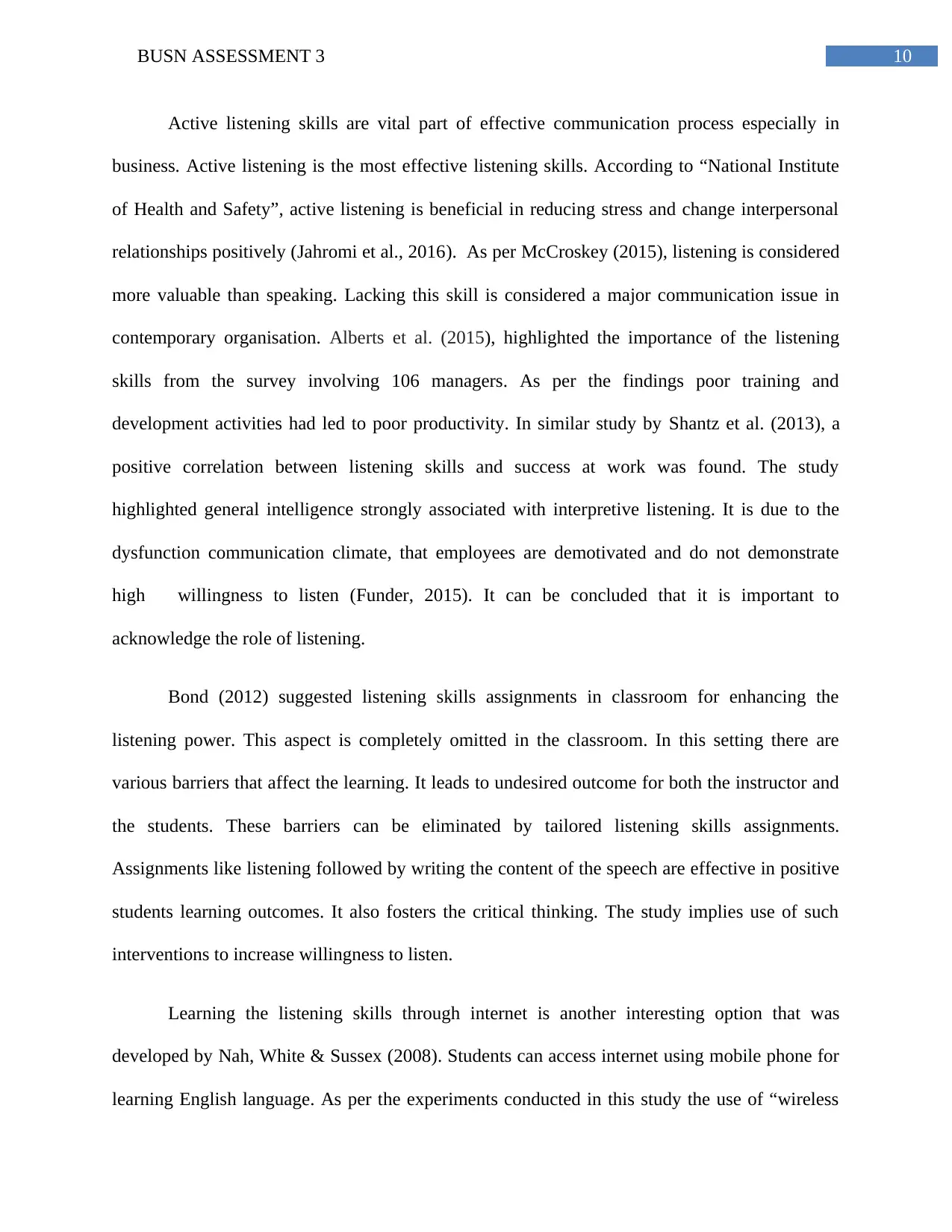
10BUSN ASSESSMENT 3
Active listening skills are vital part of effective communication process especially in
business. Active listening is the most effective listening skills. According to “National Institute
of Health and Safety”, active listening is beneficial in reducing stress and change interpersonal
relationships positively (Jahromi et al., 2016). As per McCroskey (2015), listening is considered
more valuable than speaking. Lacking this skill is considered a major communication issue in
contemporary organisation. Alberts et al. (2015), highlighted the importance of the listening
skills from the survey involving 106 managers. As per the findings poor training and
development activities had led to poor productivity. In similar study by Shantz et al. (2013), a
positive correlation between listening skills and success at work was found. The study
highlighted general intelligence strongly associated with interpretive listening. It is due to the
dysfunction communication climate, that employees are demotivated and do not demonstrate
high willingness to listen (Funder, 2015). It can be concluded that it is important to
acknowledge the role of listening.
Bond (2012) suggested listening skills assignments in classroom for enhancing the
listening power. This aspect is completely omitted in the classroom. In this setting there are
various barriers that affect the learning. It leads to undesired outcome for both the instructor and
the students. These barriers can be eliminated by tailored listening skills assignments.
Assignments like listening followed by writing the content of the speech are effective in positive
students learning outcomes. It also fosters the critical thinking. The study implies use of such
interventions to increase willingness to listen.
Learning the listening skills through internet is another interesting option that was
developed by Nah, White & Sussex (2008). Students can access internet using mobile phone for
learning English language. As per the experiments conducted in this study the use of “wireless
Active listening skills are vital part of effective communication process especially in
business. Active listening is the most effective listening skills. According to “National Institute
of Health and Safety”, active listening is beneficial in reducing stress and change interpersonal
relationships positively (Jahromi et al., 2016). As per McCroskey (2015), listening is considered
more valuable than speaking. Lacking this skill is considered a major communication issue in
contemporary organisation. Alberts et al. (2015), highlighted the importance of the listening
skills from the survey involving 106 managers. As per the findings poor training and
development activities had led to poor productivity. In similar study by Shantz et al. (2013), a
positive correlation between listening skills and success at work was found. The study
highlighted general intelligence strongly associated with interpretive listening. It is due to the
dysfunction communication climate, that employees are demotivated and do not demonstrate
high willingness to listen (Funder, 2015). It can be concluded that it is important to
acknowledge the role of listening.
Bond (2012) suggested listening skills assignments in classroom for enhancing the
listening power. This aspect is completely omitted in the classroom. In this setting there are
various barriers that affect the learning. It leads to undesired outcome for both the instructor and
the students. These barriers can be eliminated by tailored listening skills assignments.
Assignments like listening followed by writing the content of the speech are effective in positive
students learning outcomes. It also fosters the critical thinking. The study implies use of such
interventions to increase willingness to listen.
Learning the listening skills through internet is another interesting option that was
developed by Nah, White & Sussex (2008). Students can access internet using mobile phone for
learning English language. As per the experiments conducted in this study the use of “wireless
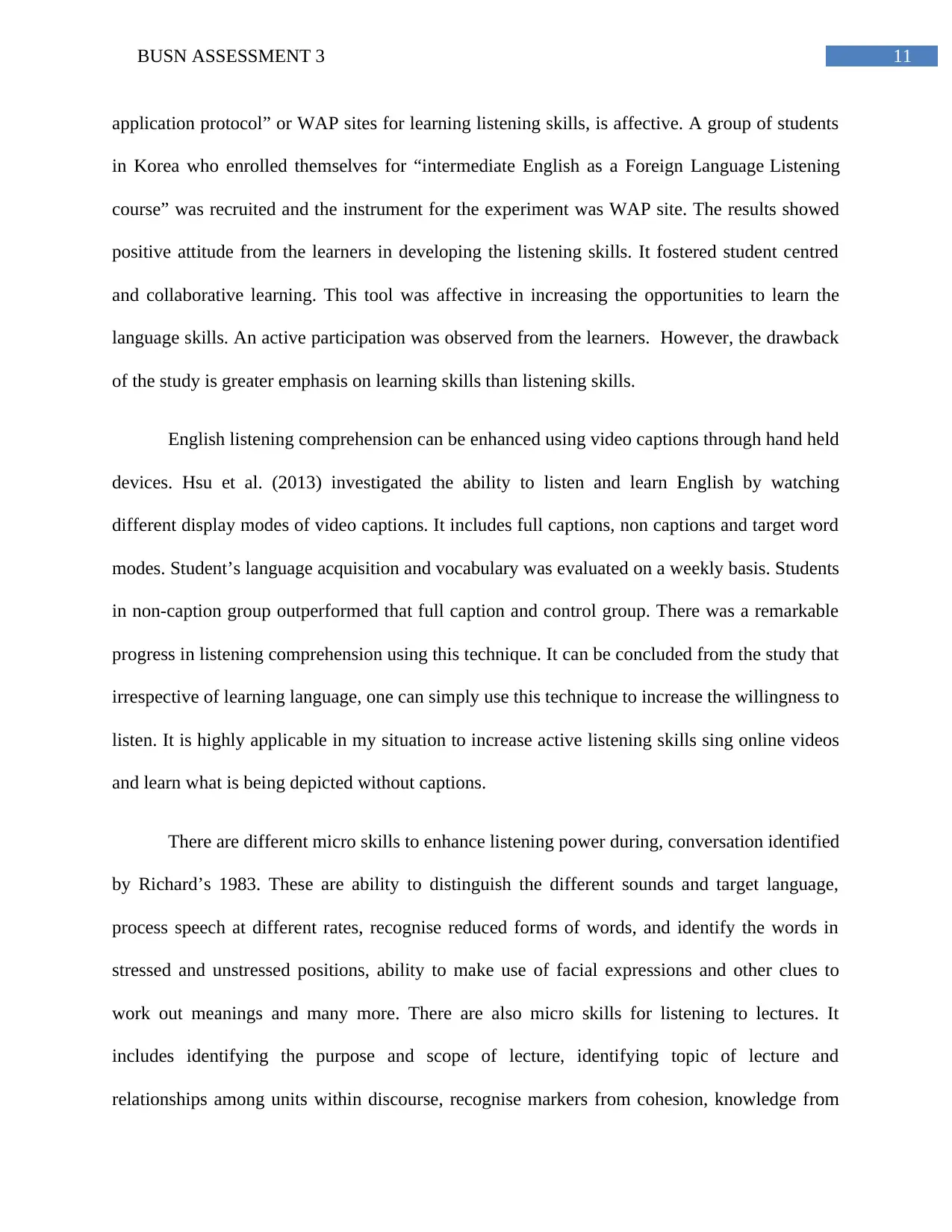
11BUSN ASSESSMENT 3
application protocol” or WAP sites for learning listening skills, is affective. A group of students
in Korea who enrolled themselves for “intermediate English as a Foreign Language Listening
course” was recruited and the instrument for the experiment was WAP site. The results showed
positive attitude from the learners in developing the listening skills. It fostered student centred
and collaborative learning. This tool was affective in increasing the opportunities to learn the
language skills. An active participation was observed from the learners. However, the drawback
of the study is greater emphasis on learning skills than listening skills.
English listening comprehension can be enhanced using video captions through hand held
devices. Hsu et al. (2013) investigated the ability to listen and learn English by watching
different display modes of video captions. It includes full captions, non captions and target word
modes. Student’s language acquisition and vocabulary was evaluated on a weekly basis. Students
in non-caption group outperformed that full caption and control group. There was a remarkable
progress in listening comprehension using this technique. It can be concluded from the study that
irrespective of learning language, one can simply use this technique to increase the willingness to
listen. It is highly applicable in my situation to increase active listening skills sing online videos
and learn what is being depicted without captions.
There are different micro skills to enhance listening power during, conversation identified
by Richard’s 1983. These are ability to distinguish the different sounds and target language,
process speech at different rates, recognise reduced forms of words, and identify the words in
stressed and unstressed positions, ability to make use of facial expressions and other clues to
work out meanings and many more. There are also micro skills for listening to lectures. It
includes identifying the purpose and scope of lecture, identifying topic of lecture and
relationships among units within discourse, recognise markers from cohesion, knowledge from
application protocol” or WAP sites for learning listening skills, is affective. A group of students
in Korea who enrolled themselves for “intermediate English as a Foreign Language Listening
course” was recruited and the instrument for the experiment was WAP site. The results showed
positive attitude from the learners in developing the listening skills. It fostered student centred
and collaborative learning. This tool was affective in increasing the opportunities to learn the
language skills. An active participation was observed from the learners. However, the drawback
of the study is greater emphasis on learning skills than listening skills.
English listening comprehension can be enhanced using video captions through hand held
devices. Hsu et al. (2013) investigated the ability to listen and learn English by watching
different display modes of video captions. It includes full captions, non captions and target word
modes. Student’s language acquisition and vocabulary was evaluated on a weekly basis. Students
in non-caption group outperformed that full caption and control group. There was a remarkable
progress in listening comprehension using this technique. It can be concluded from the study that
irrespective of learning language, one can simply use this technique to increase the willingness to
listen. It is highly applicable in my situation to increase active listening skills sing online videos
and learn what is being depicted without captions.
There are different micro skills to enhance listening power during, conversation identified
by Richard’s 1983. These are ability to distinguish the different sounds and target language,
process speech at different rates, recognise reduced forms of words, and identify the words in
stressed and unstressed positions, ability to make use of facial expressions and other clues to
work out meanings and many more. There are also micro skills for listening to lectures. It
includes identifying the purpose and scope of lecture, identifying topic of lecture and
relationships among units within discourse, recognise markers from cohesion, knowledge from
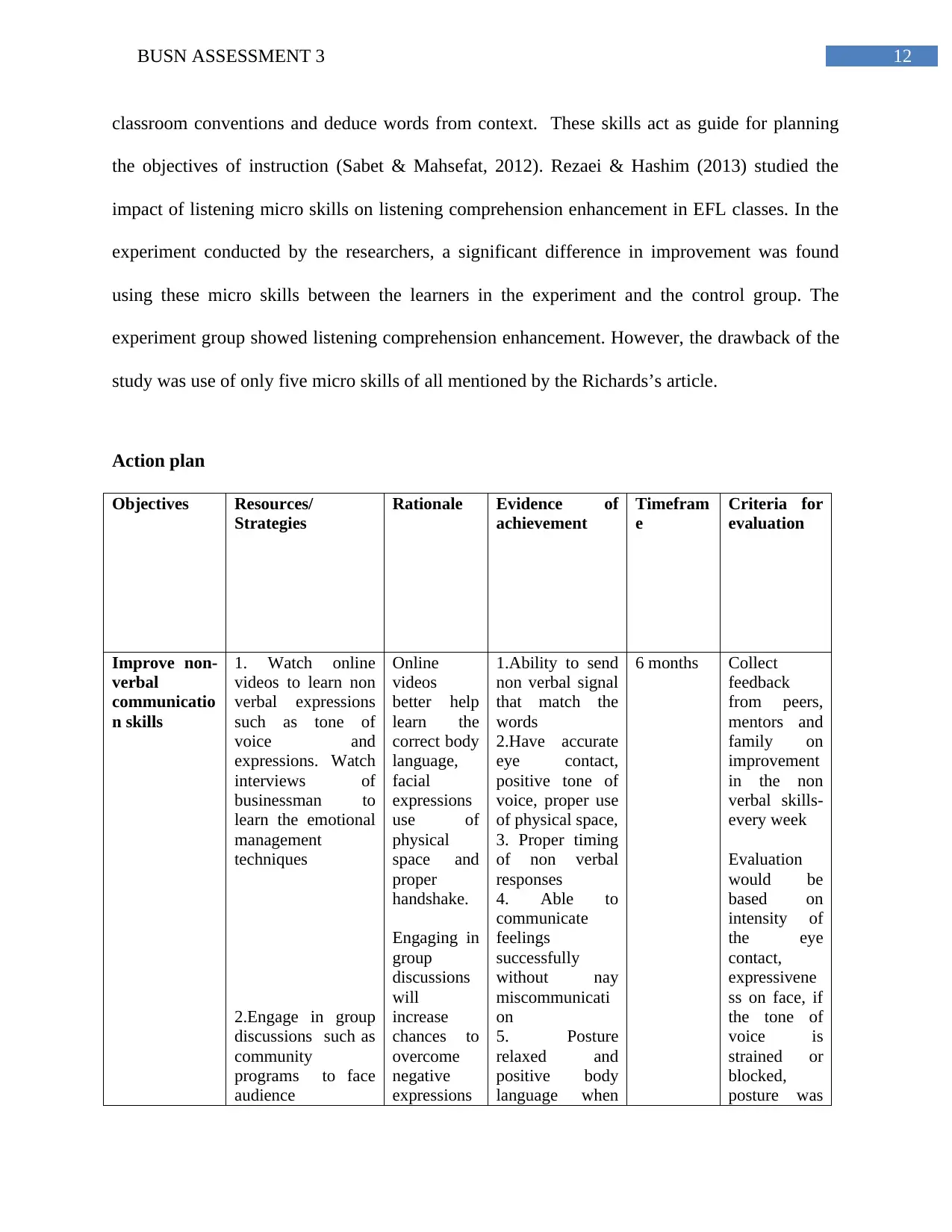
12BUSN ASSESSMENT 3
classroom conventions and deduce words from context. These skills act as guide for planning
the objectives of instruction (Sabet & Mahsefat, 2012). Rezaei & Hashim (2013) studied the
impact of listening micro skills on listening comprehension enhancement in EFL classes. In the
experiment conducted by the researchers, a significant difference in improvement was found
using these micro skills between the learners in the experiment and the control group. The
experiment group showed listening comprehension enhancement. However, the drawback of the
study was use of only five micro skills of all mentioned by the Richards’s article.
Action plan
Objectives Resources/
Strategies
Rationale Evidence of
achievement
Timefram
e
Criteria for
evaluation
Improve non-
verbal
communicatio
n skills
1. Watch online
videos to learn non
verbal expressions
such as tone of
voice and
expressions. Watch
interviews of
businessman to
learn the emotional
management
techniques
2.Engage in group
discussions such as
community
programs to face
audience
Online
videos
better help
learn the
correct body
language,
facial
expressions
use of
physical
space and
proper
handshake.
Engaging in
group
discussions
will
increase
chances to
overcome
negative
expressions
1.Ability to send
non verbal signal
that match the
words
2.Have accurate
eye contact,
positive tone of
voice, proper use
of physical space,
3. Proper timing
of non verbal
responses
4. Able to
communicate
feelings
successfully
without nay
miscommunicati
on
5. Posture
relaxed and
positive body
language when
6 months Collect
feedback
from peers,
mentors and
family on
improvement
in the non
verbal skills-
every week
Evaluation
would be
based on
intensity of
the eye
contact,
expressivene
ss on face, if
the tone of
voice is
strained or
blocked,
posture was
classroom conventions and deduce words from context. These skills act as guide for planning
the objectives of instruction (Sabet & Mahsefat, 2012). Rezaei & Hashim (2013) studied the
impact of listening micro skills on listening comprehension enhancement in EFL classes. In the
experiment conducted by the researchers, a significant difference in improvement was found
using these micro skills between the learners in the experiment and the control group. The
experiment group showed listening comprehension enhancement. However, the drawback of the
study was use of only five micro skills of all mentioned by the Richards’s article.
Action plan
Objectives Resources/
Strategies
Rationale Evidence of
achievement
Timefram
e
Criteria for
evaluation
Improve non-
verbal
communicatio
n skills
1. Watch online
videos to learn non
verbal expressions
such as tone of
voice and
expressions. Watch
interviews of
businessman to
learn the emotional
management
techniques
2.Engage in group
discussions such as
community
programs to face
audience
Online
videos
better help
learn the
correct body
language,
facial
expressions
use of
physical
space and
proper
handshake.
Engaging in
group
discussions
will
increase
chances to
overcome
negative
expressions
1.Ability to send
non verbal signal
that match the
words
2.Have accurate
eye contact,
positive tone of
voice, proper use
of physical space,
3. Proper timing
of non verbal
responses
4. Able to
communicate
feelings
successfully
without nay
miscommunicati
on
5. Posture
relaxed and
positive body
language when
6 months Collect
feedback
from peers,
mentors and
family on
improvement
in the non
verbal skills-
every week
Evaluation
would be
based on
intensity of
the eye
contact,
expressivene
ss on face, if
the tone of
voice is
strained or
blocked,
posture was
Paraphrase This Document
Need a fresh take? Get an instant paraphrase of this document with our AI Paraphraser
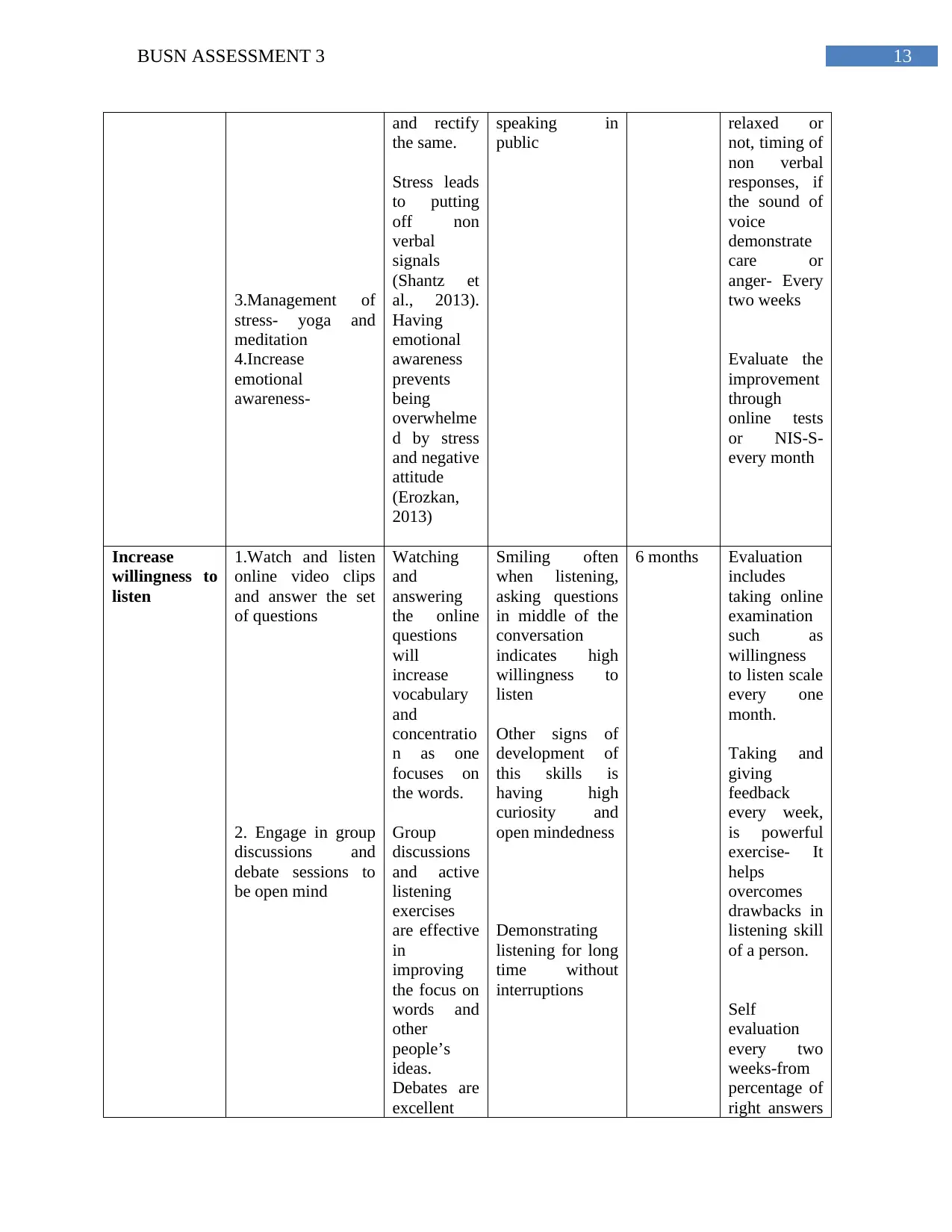
13BUSN ASSESSMENT 3
3.Management of
stress- yoga and
meditation
4.Increase
emotional
awareness-
and rectify
the same.
Stress leads
to putting
off non
verbal
signals
(Shantz et
al., 2013).
Having
emotional
awareness
prevents
being
overwhelme
d by stress
and negative
attitude
(Erozkan,
2013)
speaking in
public
relaxed or
not, timing of
non verbal
responses, if
the sound of
voice
demonstrate
care or
anger- Every
two weeks
Evaluate the
improvement
through
online tests
or NIS-S-
every month
Increase
willingness to
listen
1.Watch and listen
online video clips
and answer the set
of questions
2. Engage in group
discussions and
debate sessions to
be open mind
Watching
and
answering
the online
questions
will
increase
vocabulary
and
concentratio
n as one
focuses on
the words.
Group
discussions
and active
listening
exercises
are effective
in
improving
the focus on
words and
other
people’s
ideas.
Debates are
excellent
Smiling often
when listening,
asking questions
in middle of the
conversation
indicates high
willingness to
listen
Other signs of
development of
this skills is
having high
curiosity and
open mindedness
Demonstrating
listening for long
time without
interruptions
6 months Evaluation
includes
taking online
examination
such as
willingness
to listen scale
every one
month.
Taking and
giving
feedback
every week,
is powerful
exercise- It
helps
overcomes
drawbacks in
listening skill
of a person.
Self
evaluation
every two
weeks-from
percentage of
right answers
3.Management of
stress- yoga and
meditation
4.Increase
emotional
awareness-
and rectify
the same.
Stress leads
to putting
off non
verbal
signals
(Shantz et
al., 2013).
Having
emotional
awareness
prevents
being
overwhelme
d by stress
and negative
attitude
(Erozkan,
2013)
speaking in
public
relaxed or
not, timing of
non verbal
responses, if
the sound of
voice
demonstrate
care or
anger- Every
two weeks
Evaluate the
improvement
through
online tests
or NIS-S-
every month
Increase
willingness to
listen
1.Watch and listen
online video clips
and answer the set
of questions
2. Engage in group
discussions and
debate sessions to
be open mind
Watching
and
answering
the online
questions
will
increase
vocabulary
and
concentratio
n as one
focuses on
the words.
Group
discussions
and active
listening
exercises
are effective
in
improving
the focus on
words and
other
people’s
ideas.
Debates are
excellent
Smiling often
when listening,
asking questions
in middle of the
conversation
indicates high
willingness to
listen
Other signs of
development of
this skills is
having high
curiosity and
open mindedness
Demonstrating
listening for long
time without
interruptions
6 months Evaluation
includes
taking online
examination
such as
willingness
to listen scale
every one
month.
Taking and
giving
feedback
every week,
is powerful
exercise- It
helps
overcomes
drawbacks in
listening skill
of a person.
Self
evaluation
every two
weeks-from
percentage of
right answers
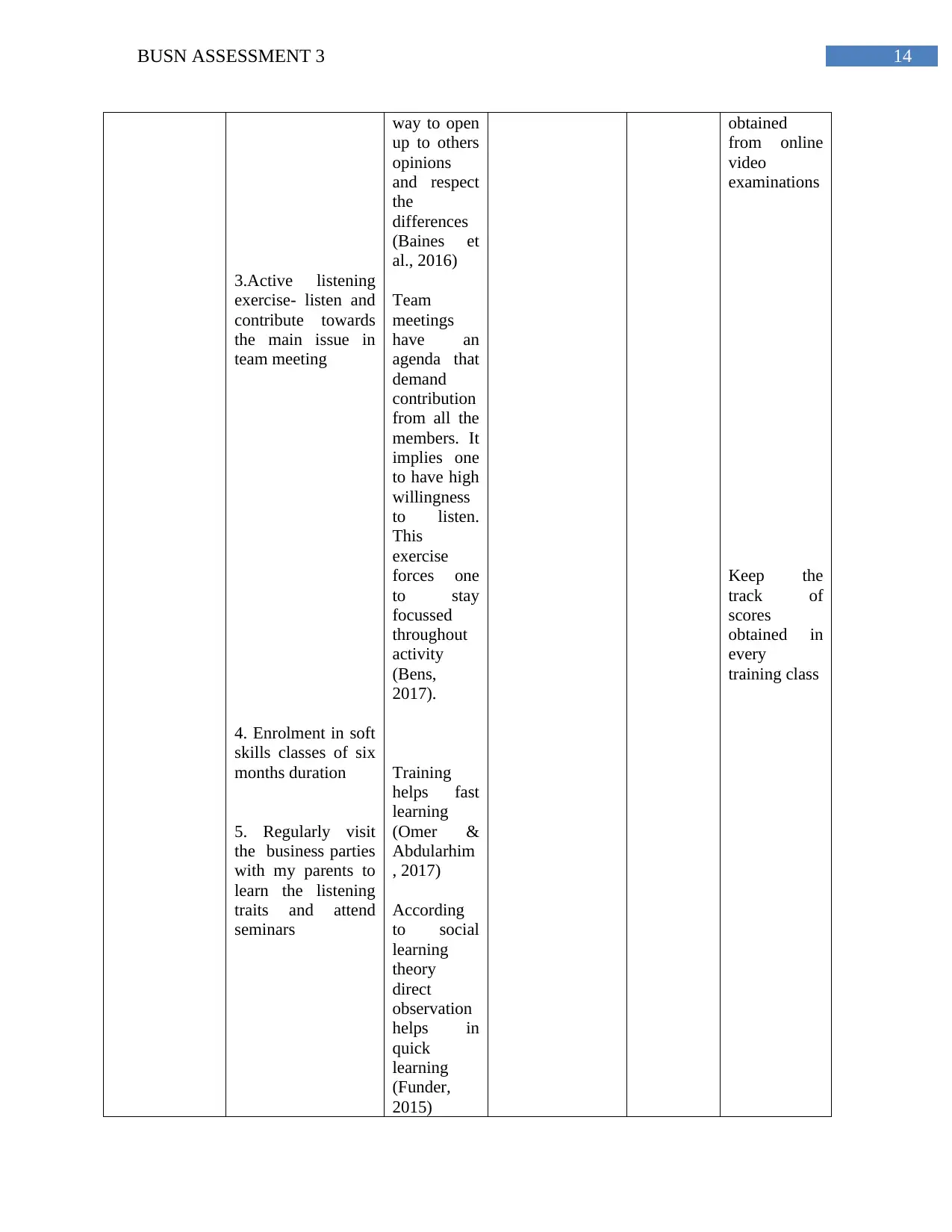
14BUSN ASSESSMENT 3
3.Active listening
exercise- listen and
contribute towards
the main issue in
team meeting
4. Enrolment in soft
skills classes of six
months duration
5. Regularly visit
the business parties
with my parents to
learn the listening
traits and attend
seminars
way to open
up to others
opinions
and respect
the
differences
(Baines et
al., 2016)
Team
meetings
have an
agenda that
demand
contribution
from all the
members. It
implies one
to have high
willingness
to listen.
This
exercise
forces one
to stay
focussed
throughout
activity
(Bens,
2017).
Training
helps fast
learning
(Omer &
Abdularhim
, 2017)
According
to social
learning
theory
direct
observation
helps in
quick
learning
(Funder,
2015)
obtained
from online
video
examinations
Keep the
track of
scores
obtained in
every
training class
3.Active listening
exercise- listen and
contribute towards
the main issue in
team meeting
4. Enrolment in soft
skills classes of six
months duration
5. Regularly visit
the business parties
with my parents to
learn the listening
traits and attend
seminars
way to open
up to others
opinions
and respect
the
differences
(Baines et
al., 2016)
Team
meetings
have an
agenda that
demand
contribution
from all the
members. It
implies one
to have high
willingness
to listen.
This
exercise
forces one
to stay
focussed
throughout
activity
(Bens,
2017).
Training
helps fast
learning
(Omer &
Abdularhim
, 2017)
According
to social
learning
theory
direct
observation
helps in
quick
learning
(Funder,
2015)
obtained
from online
video
examinations
Keep the
track of
scores
obtained in
every
training class
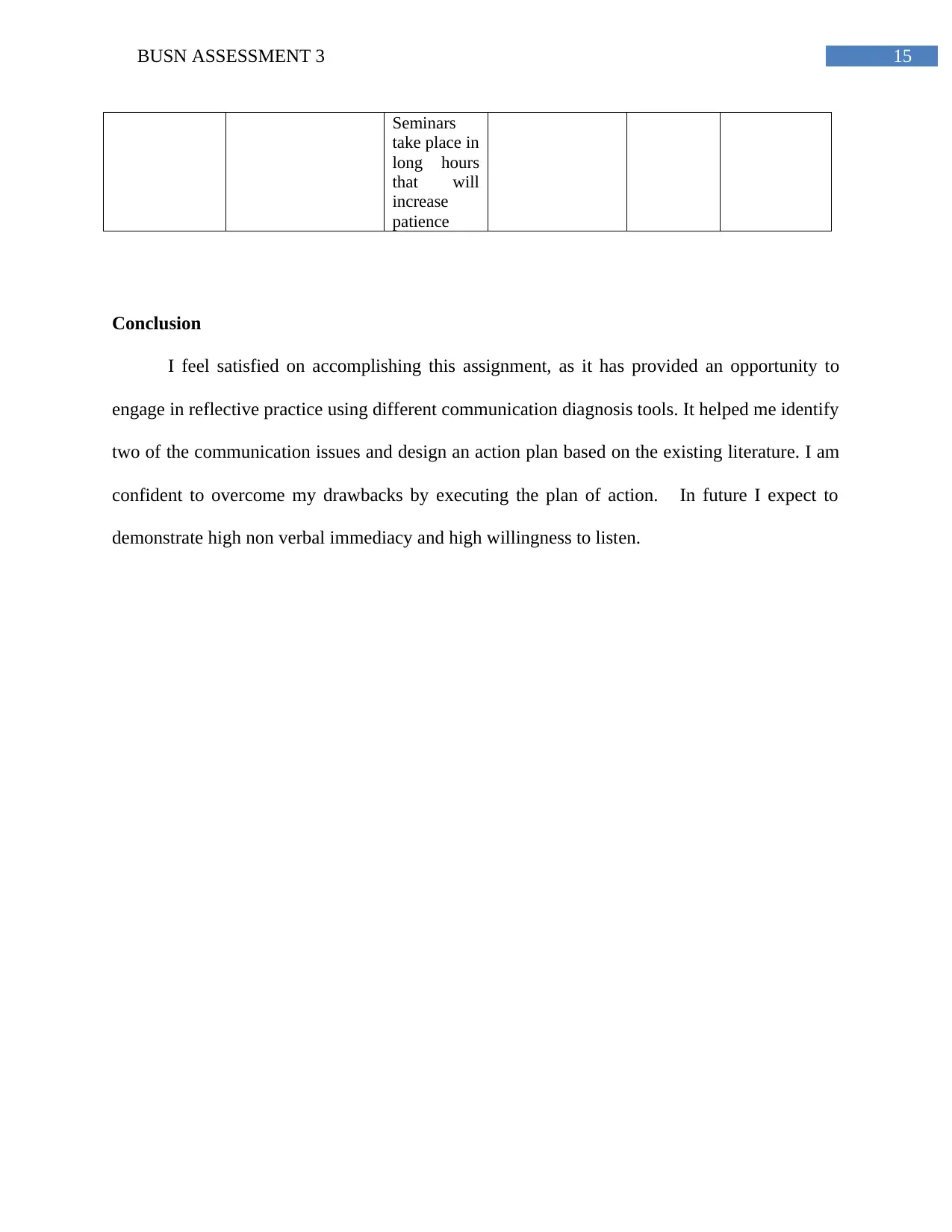
15BUSN ASSESSMENT 3
Seminars
take place in
long hours
that will
increase
patience
Conclusion
I feel satisfied on accomplishing this assignment, as it has provided an opportunity to
engage in reflective practice using different communication diagnosis tools. It helped me identify
two of the communication issues and design an action plan based on the existing literature. I am
confident to overcome my drawbacks by executing the plan of action. In future I expect to
demonstrate high non verbal immediacy and high willingness to listen.
Seminars
take place in
long hours
that will
increase
patience
Conclusion
I feel satisfied on accomplishing this assignment, as it has provided an opportunity to
engage in reflective practice using different communication diagnosis tools. It helped me identify
two of the communication issues and design an action plan based on the existing literature. I am
confident to overcome my drawbacks by executing the plan of action. In future I expect to
demonstrate high non verbal immediacy and high willingness to listen.
Secure Best Marks with AI Grader
Need help grading? Try our AI Grader for instant feedback on your assignments.

16BUSN ASSESSMENT 3
References
Alberts, J. K., Nakayama, T. K., & Martin, J. N. (2015). Human communication in society.
Pearson.
Baines, E., Blatchford, P., & Kutnick, P. (2016). Promoting effective group work in the primary
classroom: A handbook for teachers and practitioners. Routledge.
Bens, I. (2017). Facilitating with Ease!: core skills for facilitators, team leaders and members,
managers, consultants, and trainers. John Wiley & Sons.
Bond, C. D. (2012). An overview of best practices to teach listening skills. International Journal
of Listening, 26(2), 61-63.
Burgoon, J. K., Guerrero, L. K., & Manusov, V. (2011). Nonverbal signals. The SAGE handbook
of interpersonal communication. London: SAGE.
Erozkan, A. (2013). The Effect of Communication Skills and Interpersonal Problem Solving
Skills on Social Self-Efficacy. Educational Sciences: Theory and Practice, 13(2), 739-
745.
Funder, D. C. (2015). The Personality Puzzle: Seventh International Student Edition. WW
Norton & Company.
Gearhart, C. C., & Bodie, G. D. (2011). Active-empathic listening as a general social skill:
Evidence from bivariate and canonical correlations. Communication Reports, 24(2), 86-
98.
References
Alberts, J. K., Nakayama, T. K., & Martin, J. N. (2015). Human communication in society.
Pearson.
Baines, E., Blatchford, P., & Kutnick, P. (2016). Promoting effective group work in the primary
classroom: A handbook for teachers and practitioners. Routledge.
Bens, I. (2017). Facilitating with Ease!: core skills for facilitators, team leaders and members,
managers, consultants, and trainers. John Wiley & Sons.
Bond, C. D. (2012). An overview of best practices to teach listening skills. International Journal
of Listening, 26(2), 61-63.
Burgoon, J. K., Guerrero, L. K., & Manusov, V. (2011). Nonverbal signals. The SAGE handbook
of interpersonal communication. London: SAGE.
Erozkan, A. (2013). The Effect of Communication Skills and Interpersonal Problem Solving
Skills on Social Self-Efficacy. Educational Sciences: Theory and Practice, 13(2), 739-
745.
Funder, D. C. (2015). The Personality Puzzle: Seventh International Student Edition. WW
Norton & Company.
Gearhart, C. C., & Bodie, G. D. (2011). Active-empathic listening as a general social skill:
Evidence from bivariate and canonical correlations. Communication Reports, 24(2), 86-
98.
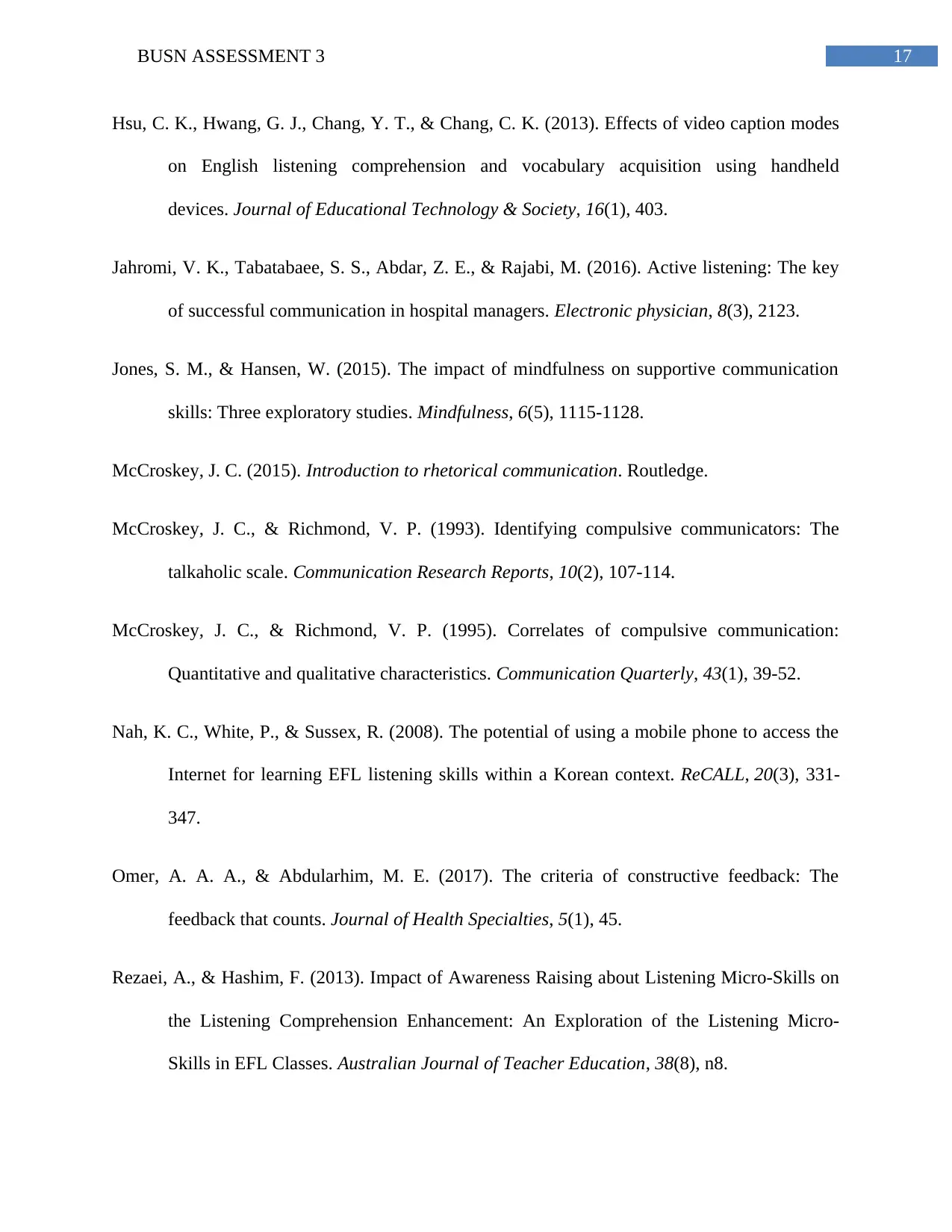
17BUSN ASSESSMENT 3
Hsu, C. K., Hwang, G. J., Chang, Y. T., & Chang, C. K. (2013). Effects of video caption modes
on English listening comprehension and vocabulary acquisition using handheld
devices. Journal of Educational Technology & Society, 16(1), 403.
Jahromi, V. K., Tabatabaee, S. S., Abdar, Z. E., & Rajabi, M. (2016). Active listening: The key
of successful communication in hospital managers. Electronic physician, 8(3), 2123.
Jones, S. M., & Hansen, W. (2015). The impact of mindfulness on supportive communication
skills: Three exploratory studies. Mindfulness, 6(5), 1115-1128.
McCroskey, J. C. (2015). Introduction to rhetorical communication. Routledge.
McCroskey, J. C., & Richmond, V. P. (1993). Identifying compulsive communicators: The
talkaholic scale. Communication Research Reports, 10(2), 107-114.
McCroskey, J. C., & Richmond, V. P. (1995). Correlates of compulsive communication:
Quantitative and qualitative characteristics. Communication Quarterly, 43(1), 39-52.
Nah, K. C., White, P., & Sussex, R. (2008). The potential of using a mobile phone to access the
Internet for learning EFL listening skills within a Korean context. ReCALL, 20(3), 331-
347.
Omer, A. A. A., & Abdularhim, M. E. (2017). The criteria of constructive feedback: The
feedback that counts. Journal of Health Specialties, 5(1), 45.
Rezaei, A., & Hashim, F. (2013). Impact of Awareness Raising about Listening Micro-Skills on
the Listening Comprehension Enhancement: An Exploration of the Listening Micro-
Skills in EFL Classes. Australian Journal of Teacher Education, 38(8), n8.
Hsu, C. K., Hwang, G. J., Chang, Y. T., & Chang, C. K. (2013). Effects of video caption modes
on English listening comprehension and vocabulary acquisition using handheld
devices. Journal of Educational Technology & Society, 16(1), 403.
Jahromi, V. K., Tabatabaee, S. S., Abdar, Z. E., & Rajabi, M. (2016). Active listening: The key
of successful communication in hospital managers. Electronic physician, 8(3), 2123.
Jones, S. M., & Hansen, W. (2015). The impact of mindfulness on supportive communication
skills: Three exploratory studies. Mindfulness, 6(5), 1115-1128.
McCroskey, J. C. (2015). Introduction to rhetorical communication. Routledge.
McCroskey, J. C., & Richmond, V. P. (1993). Identifying compulsive communicators: The
talkaholic scale. Communication Research Reports, 10(2), 107-114.
McCroskey, J. C., & Richmond, V. P. (1995). Correlates of compulsive communication:
Quantitative and qualitative characteristics. Communication Quarterly, 43(1), 39-52.
Nah, K. C., White, P., & Sussex, R. (2008). The potential of using a mobile phone to access the
Internet for learning EFL listening skills within a Korean context. ReCALL, 20(3), 331-
347.
Omer, A. A. A., & Abdularhim, M. E. (2017). The criteria of constructive feedback: The
feedback that counts. Journal of Health Specialties, 5(1), 45.
Rezaei, A., & Hashim, F. (2013). Impact of Awareness Raising about Listening Micro-Skills on
the Listening Comprehension Enhancement: An Exploration of the Listening Micro-
Skills in EFL Classes. Australian Journal of Teacher Education, 38(8), n8.
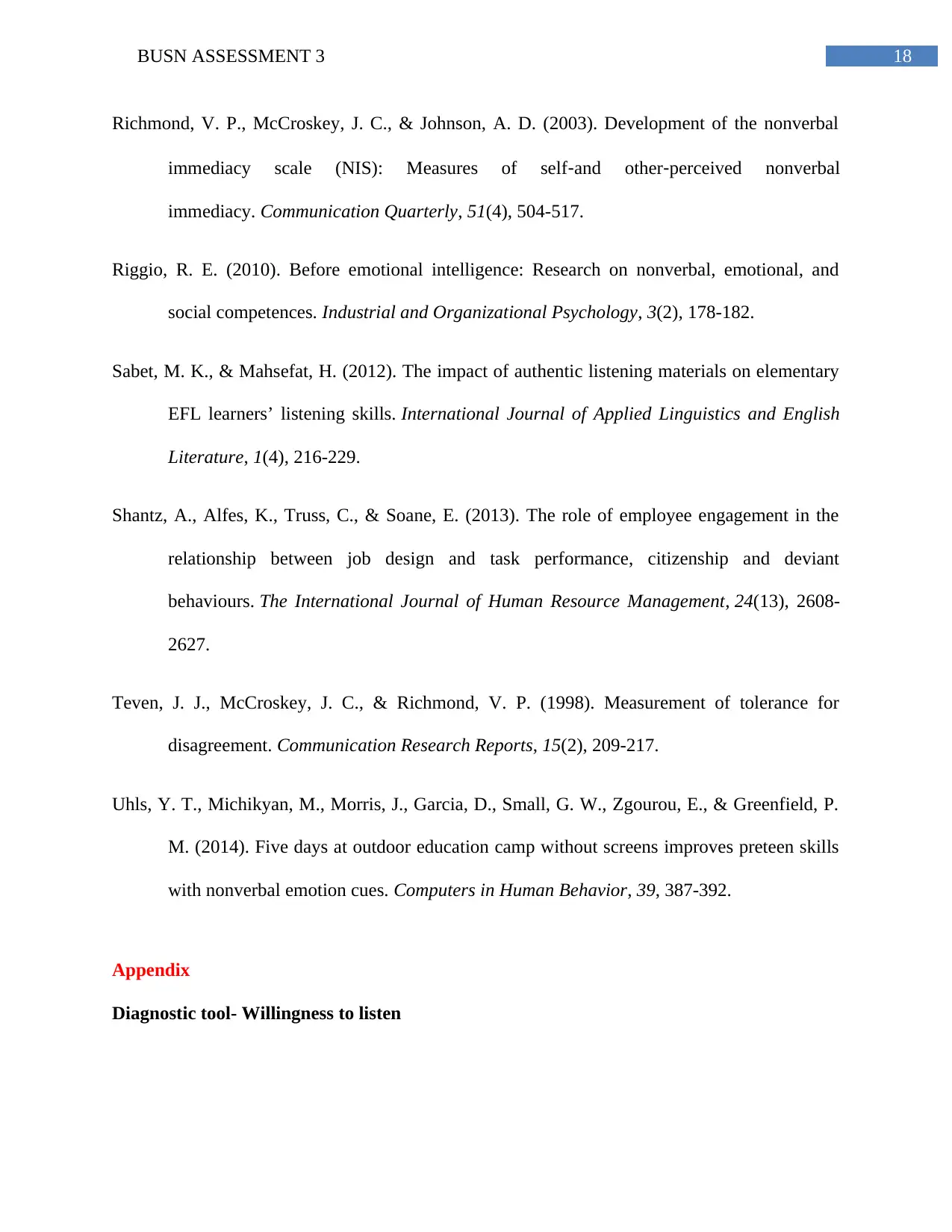
18BUSN ASSESSMENT 3
Richmond, V. P., McCroskey, J. C., & Johnson, A. D. (2003). Development of the nonverbal
immediacy scale (NIS): Measures of self‐and other‐perceived nonverbal
immediacy. Communication Quarterly, 51(4), 504-517.
Riggio, R. E. (2010). Before emotional intelligence: Research on nonverbal, emotional, and
social competences. Industrial and Organizational Psychology, 3(2), 178-182.
Sabet, M. K., & Mahsefat, H. (2012). The impact of authentic listening materials on elementary
EFL learners’ listening skills. International Journal of Applied Linguistics and English
Literature, 1(4), 216-229.
Shantz, A., Alfes, K., Truss, C., & Soane, E. (2013). The role of employee engagement in the
relationship between job design and task performance, citizenship and deviant
behaviours. The International Journal of Human Resource Management, 24(13), 2608-
2627.
Teven, J. J., McCroskey, J. C., & Richmond, V. P. (1998). Measurement of tolerance for
disagreement. Communication Research Reports, 15(2), 209-217.
Uhls, Y. T., Michikyan, M., Morris, J., Garcia, D., Small, G. W., Zgourou, E., & Greenfield, P.
M. (2014). Five days at outdoor education camp without screens improves preteen skills
with nonverbal emotion cues. Computers in Human Behavior, 39, 387-392.
Appendix
Diagnostic tool- Willingness to listen
Richmond, V. P., McCroskey, J. C., & Johnson, A. D. (2003). Development of the nonverbal
immediacy scale (NIS): Measures of self‐and other‐perceived nonverbal
immediacy. Communication Quarterly, 51(4), 504-517.
Riggio, R. E. (2010). Before emotional intelligence: Research on nonverbal, emotional, and
social competences. Industrial and Organizational Psychology, 3(2), 178-182.
Sabet, M. K., & Mahsefat, H. (2012). The impact of authentic listening materials on elementary
EFL learners’ listening skills. International Journal of Applied Linguistics and English
Literature, 1(4), 216-229.
Shantz, A., Alfes, K., Truss, C., & Soane, E. (2013). The role of employee engagement in the
relationship between job design and task performance, citizenship and deviant
behaviours. The International Journal of Human Resource Management, 24(13), 2608-
2627.
Teven, J. J., McCroskey, J. C., & Richmond, V. P. (1998). Measurement of tolerance for
disagreement. Communication Research Reports, 15(2), 209-217.
Uhls, Y. T., Michikyan, M., Morris, J., Garcia, D., Small, G. W., Zgourou, E., & Greenfield, P.
M. (2014). Five days at outdoor education camp without screens improves preteen skills
with nonverbal emotion cues. Computers in Human Behavior, 39, 387-392.
Appendix
Diagnostic tool- Willingness to listen
Paraphrase This Document
Need a fresh take? Get an instant paraphrase of this document with our AI Paraphraser
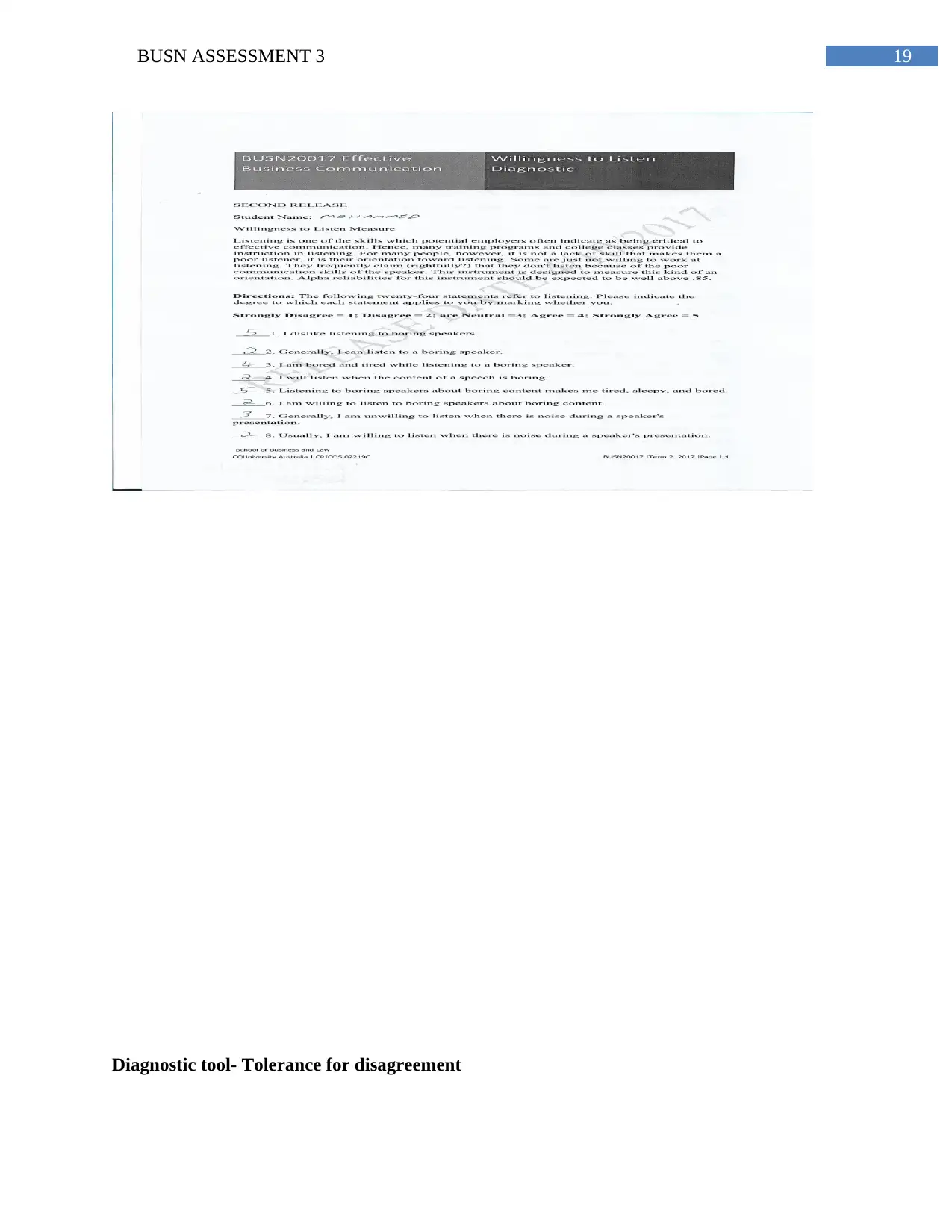
19BUSN ASSESSMENT 3
Diagnostic tool- Tolerance for disagreement
Diagnostic tool- Tolerance for disagreement
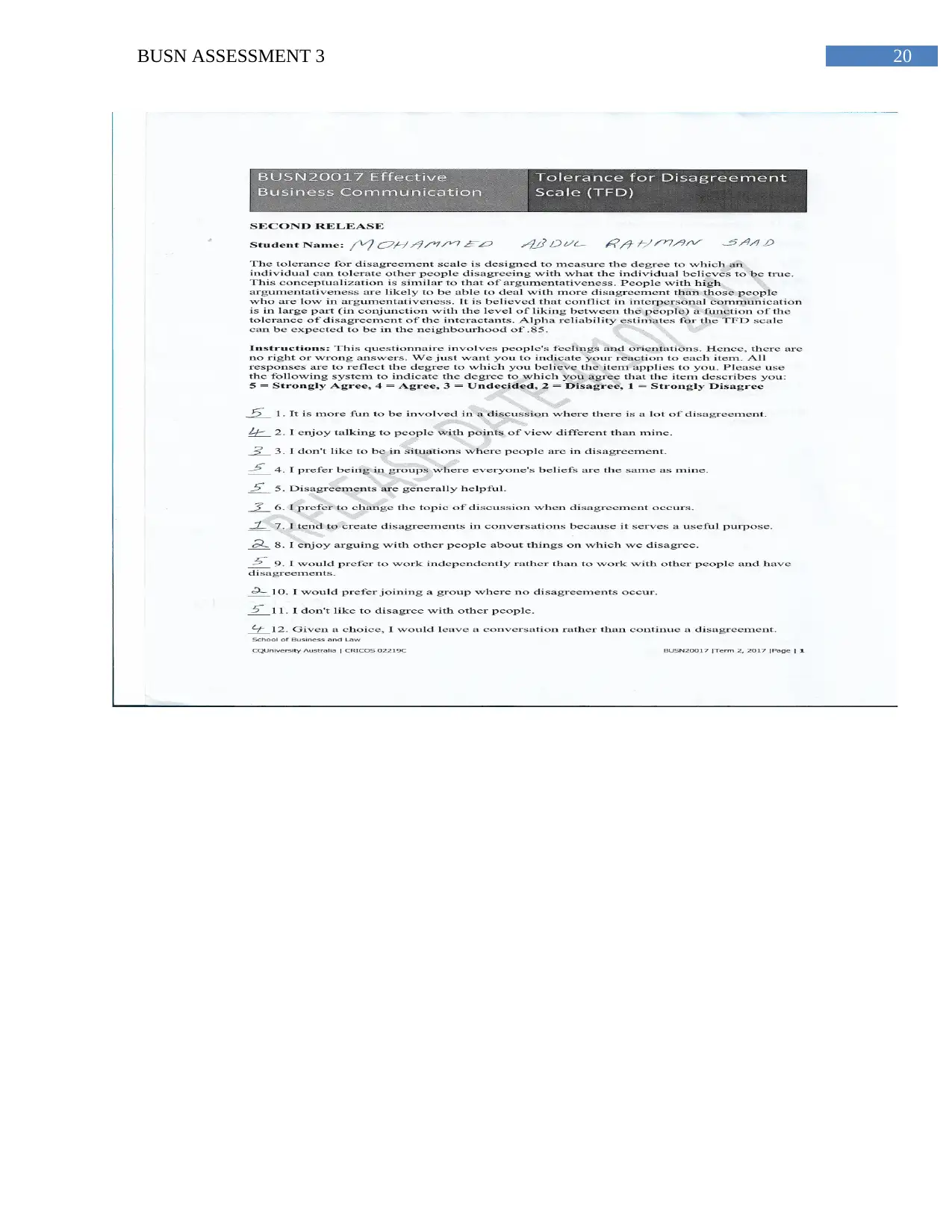
20BUSN ASSESSMENT 3

21BUSN ASSESSMENT 3
Diagnostic tool- Talkaholic scale
Diagnostic tool- Talkaholic scale
Secure Best Marks with AI Grader
Need help grading? Try our AI Grader for instant feedback on your assignments.
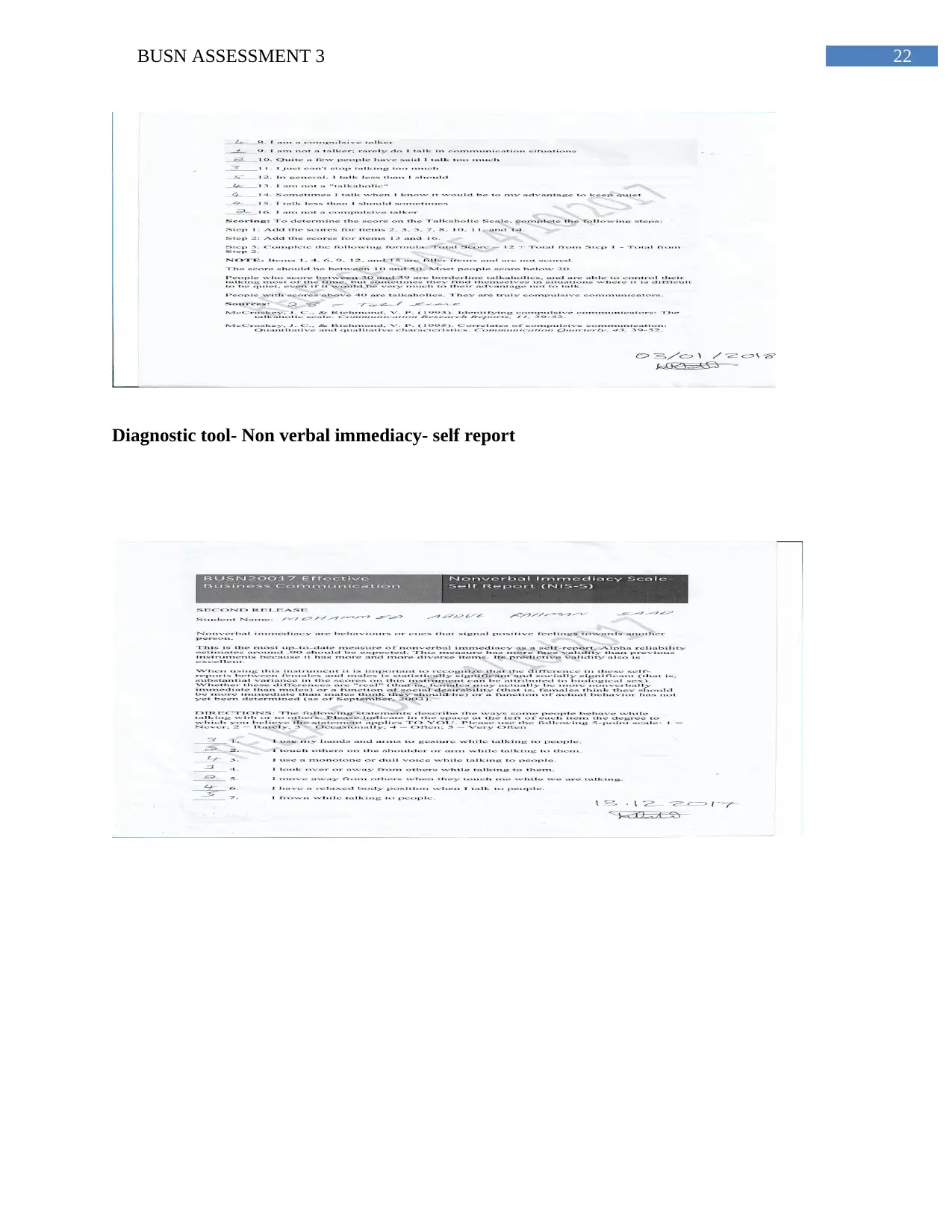
22BUSN ASSESSMENT 3
Diagnostic tool- Non verbal immediacy- self report
Diagnostic tool- Non verbal immediacy- self report

23BUSN ASSESSMENT 3
1 out of 24
Related Documents
Your All-in-One AI-Powered Toolkit for Academic Success.
+13062052269
info@desklib.com
Available 24*7 on WhatsApp / Email
![[object Object]](/_next/static/media/star-bottom.7253800d.svg)
Unlock your academic potential
© 2024 | Zucol Services PVT LTD | All rights reserved.



